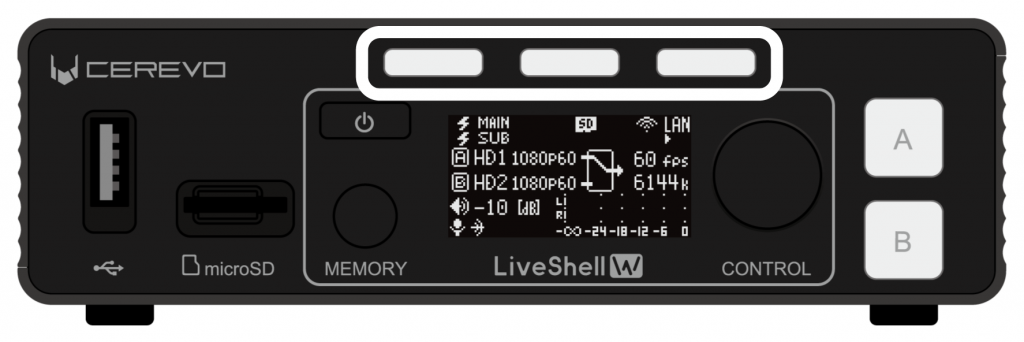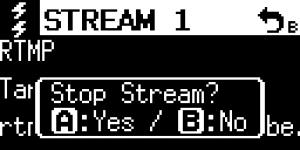Introduction
About this document
Thank you for purchasing Cerevo LiveShell W.
This document is a manual explaining how to use the LiveShell W (hereinafter referred to as "this product"). Please read this manual to the end before use and use this product with full understanding of how to handle it properly.
Scope of coverage
This manual describes the general information required to use this product, including installation, setup, operating procedures, and restrictions. In addition to this manual, the following documents are provided.
A quick setup guide included with this product.
Firmware release notes
Revision information
This manual is version 1.4.1 (released on 28th February 2023). This manual applies to the following revisions of LiveShell W.
Hardware Revision Rev. A
Firmware version v1.4.1 -> Release note
Revision history
Firmware 1.0 (Released 18th August 2022)
First edition
Firmware 1.1 (Released 30th September 2022)
With the release of firmware version v1.1.0, added explanations related to the newly implemented functions.
Other minor corrections, such as typographical errors, were made.
Firmware 1.2 (Released 12th October 2022)
With the release of firmware version v1.2.0, added explanations related to the newly implemented functions.
Firmware 1.2.1 (Released 15th October 2022)
With the release of firmware version v1.2.1, added explanations related to the firmware revision history.
Other minor corrections, such as typographical errors, were made.
Firmware 1.2.1-b (Released 20th October 2022)
Separated the firmware update guide as a separate document.
Firmware 1.3.0 (Released 30th November 2022)
With the release of firmware version v1.3.0, some description were revised.
With the addition of the function, "left-right split" was changed to "split".
Firmware 1.4.0 (Released 27th December 2022)
With the release of firmware version v1.4.0, some description were revised.
Firmware 1.4.1 (Released 28th February 2023)
With the release of firmware version v1.4.1, updated release history.
Prerequisite knowledge
This manual assumes that the reader has the following knowledge:
How to interconnect video devices using an HDMI cable
How to interconnect audio equipment using audio signal cables
Basic understanding of local networks using Ethernet (IEEE 802.3) and wireless LAN (IEEE 802.11)
Basic understanding of IP network operation and interface configuration
How to register a live streaming platform and obtain stream keys, etc.
For your safety
Meaning of symbols
In this chapter, sentences starting with [⚠️WARNING] and [⚠️CAUTION] describe information that is very important for the safe use of this product. [⚠️WARNING] and [⚠️CAUTION] respectively refer to the following.
[⚠️WARNING] Failure to comply this warning may result in death or serious bodily harm.
[⚠️CAUTION] Failure to comply this caution may result in bodily injury or equipment damage.
Safety warnings and precautions
In the event of an abnormal situation
[⚠️WARNING] If abnormal conditions such as smoke or unusual smells come out of this product or cables, etc., stop using it immediately and disconnect the power supply cable. Continued use under such conditions may result in malfunction, electric shock, or fire. After confirming that no smoke is emitted, contact your dealer or our support center. Do not attempt to repair this product by yourself as it is dangerous.
About power supply
[⚠️WARNING] Use power and power-supply cables that meet all the requirements described in this manual. Using incompatible cables may result in malfunction of this product, electric shock, overheating, smoking, or fire.
[⚠️WARNING] Never use the power-supply cable if it is damaged, conductor wires are exposed, or is broken. Doing so may result in a malfunction of this product, electric shock, overheating, smoking, or fire.
[⚠️WARNING] Do not use this product with dust or other foreign matter or liquid adhering to the power-supply connector. Doing so may result in a malfunction of this product, electric shock, overheating, smoking, or fire.
Temperature rise
[⚠️CAUTION] The surface of this product may become hot due to heat dissipation and may cause burns if touched. Please handle this product with care during and after use until the temperature cools down.
Prohibited acts
[⚠️WARNING] Do not disassemble or modify this product. Doing so may result in malfunction of this product, electric shock, overheating, smoking, or fire.
[⚠️WARNING] Do not short-circuit the connectors of this product or connect devices other than those indicated in this manual. Doing so may result in malfunction of this product, electric shock, overheating, smoking, or fire.
[⚠️CAUTION] When connecting external devices to this product, turn off the power of all devices first. Connecting external devices with the power on may cause malfunction or damage to this product.
Installation environment
[⚠️CAUTION] Do not use this product under the following conditions or environment. Doing so may result in malfunction, failure, or deformation.
Places directly exposed to wind from heaters, air conditioners, etc., or where there is a sudden change in temperature
Places exposed to direct sunlight or in a car under a hot sun
Places subjected to sea breezes or continuous high humidity
In a liquid or in a corrosive atmosphere
Places subject to strong vibrations
Places where there are strong electromagnetic field
Places where static electricity is generated
Other similar conditions
Function overview
This product is a network video encoder equipped with a 2-input video switcher and audio mixer. This product has two HDMI video and audio inputs and can receive video and audio signals from these inputs simultaneously. The video singals are switched, scalled, composted and other process from the HDMI inputs, and then encoded using H.264. Audio signals are mixed with analog audio input from the LINE and MIC, and then encoded using AAC-LC.
The encoded video and audio streams can be sent to the IP network in real time using protocols such as RTMP and RTSP. The video and audio streams can also be stored on SD memory cards or USB memory devices.
Names and functions of each part
The names and functions of the part of this product are shown in the figure below.


Front
OLED display
The OLED display is used to show the operating status of this product. The menu is displayed during the settings using the buttons on the main unit.
→ Information on the main status screen
Control dial
This dial is used during the settings and perform other operations on this product.
MicroSD card slot
This is used to insert a microSD card for video recording.
USB adapter port
USB A port for connecting accessories for this product.
Rear
USB Type-C port for power supply
These are for the power supplies for this product; two inputs, MAIN and SUB.
→ Connection between the power supply and this product
Ethernet port
For connecting this product to the network, 1000BASE-T Gigabit Ethernet interface.
→ Connecting via Ethernet
USB adapter port
USB A port for connecting a wireless LAN adapter to this product.
→ Connecting via wireless LAN
LINE IN
3.5mm stereo jack for line-level analog audio signal input to this product.
→ Analog audio source input
MIC IN
3.5 mm monaural jack for inputting a microphone-level analog audio signal to this product.
→ Analog audio source input
HDMI IN 1
This is one of the HDMI inputs for inputting video and audio signals to this product.
→ HDMI source input
HDMI IN 2
This is one of the HDMI inputs for input video and audio signals to this product.
→ HDMI source input
HDMI OUT
HDMI OUT is for a HDMI output port to monitor the video and audio signals being streamed by this product.
→ Video monitor output connection
Side
1/4-20 UNC Nut
These nuts are to mount this product on a tripod, etc. (right side)
ISO M4 Nut
These nuts are used to secure this product.
Bottom
ISO M3 Nut
These nuts are used to secure this product to shelves, etc.
Items you need in addition to this product
The following items are required to use this product (this list is only an example; actual required devices may vary depending on the usage).
A device with a web browser (PC, tablet, smartphone, etc.) to operate this product
Video source devices capable of outputting video and audio via HDMI, such as cameras
Devices necessary to build a communication network that meets Network requirements requirements.
Cables, connectors, etc. to connect these devices
How to swet up and operate LiveShell W
There are two ways to set and operate various functions of this product: by using the buttons on the front of this product or by using LiveShell Studio, a web application built into this product. The features of each method are as follows, and can be used according to the contents of the operation.
Operation using LiveShell Studio
Operations using LiveShell Studio have the following characteristics.
To use LiveShell Studio, the network settings of this product must be completed.
A device that can run a web browser, such as a PC for operation, is required.
LiveShell Studio can operate all the functions of this product.
Therefore, it is suitable for more advanced settings and operations.
Example of system configuration
The figure below shows a typical configuration example of a live streaming using this product.
LiveShell W
+-------------------+
| |
Power [AC/DC]--- USB Type-C ----| POWER MAIN |
| |
| POWER SUB |
| |
CAMERA 1 |>[CAM]---- HDMI ----| INPUT 1 |
| |
CAMERA 2 |>[CAM]---- HDMI ----| INPUT 2 |
| |
DISPLAY [LCD]---- HDMI ----| OUTPUT |
| |
Music Player [MP]--- 3.5 mm ----| LINE |
| |
Microphone [MIC]-- 3.5 mm ----| MIC |
| |
+-- UTP ----| ETHERNET |
| | |
| +-------------------+
|
| +-------------------+
+-----------| |
| |
+-----------+ | |
| Laptop PC |-------------------| GbE Switch |
+-----------+ | |
+--------+ | |
The Internet <----| Router |------| |
+--------+ +-------------------+
Explanation of system configuration example
In this system configuration example, this product is powered by a single power supply from an AC adapter.
Two cameras are connected to the HDMI INPUT of this product as video sources. This makes it possible to switch and stream the images captured by each camera, or to live stream a composite image captured by both cameras, such as picture-in-picture (PinP). In addition, a display monitor can be connected to the HDMI OUTPUT to monitor the actual content being streamed.
As additional audio sources, analog audio signals from a music player and a microphone are connected to the LINE and MIC inputs of this product, respectively. These audio sources, including the two HDMI audio inputs, can be mixed at any desired level.
The Ethernet port of this product is connected to a separately prepared Gigabit Ethernet switch. The communication from this product to the Internet is come through a router that serves as the default gateway. A laptop computer running a Web browser is also connected to the same network for LiveShell Studio operation.
System configuration variations
In addition to the typical configuration examples described in the previous section, the following configurations are also possible.
Redundant power supply with two power supplies
Use a PC as a video source instead of a camera
Use only one video input system and live stream the video without using a switching function or image composite function
Use a display for monitoring without connection
Does not use analog audio inputs
Connect to a network using a wireless LAN instead of Ethernet
Please refer to the next chapter for specific connection and setup methods.
Signal flow
The signal flow inside this product is shown in the figure below.
+-----------------------------------------------------------------------+
| |
| Video Processor +---------------+ |
| ~~~~~~~~~~~~~~~ | | |
| | Frame sync | |
[ INPUT 1 ] >|=== HDMI --> Video A >--| Deinterlacer | |
| | | Scaler | +------------+ |
| +--> (Audio 1) | | | | |
| | Selector |>----| H.264 ENC |-----+ |
| | Mix/Wipe/PinP | | | | |
[ INPUT 2 ] >|=== HDMI --> Video B >--| Chromakey | +------------+ | |
| | | | | |
| +--> (Audio 2) | Overlay | | |
| | | | |
| +---------------+ | |
| | | |
| | | |
[ OUTPUT ] <|=== HDMI ---< Video monitor <---+ | |
| | | |
| +------< Audio monitor <---+------>(USB Audio Playback) | |
| | | |
| | | |
| Audio Processor | | |
| ~~~~~~~~~~~~~~~ | | |
| | | |
| --> (Audio 1) | | |
| | +---------------+ | |
| +---------------+ | | | |
| | Resampler |>---| | | |
| +---------------+ | | | |
| | | +-------------+ | |
| | Digital | | | | |
| --> (Audio 2) | mixer |>----| AAC-LC ENC | | |
| | | | | | | |
| +---------------+ | | +-------------+ | |
| | Resampler |>---| | | | |
| +---------------+ | | | | |
| +---------------+ | | |
| | | | |
| +-----+ | | | |
[ LINE ] >|---| | +-----+ +---------------+ | | |
| | MIX |>--| PGA |>---| 16 bit ADC | | | |
[ MIC ] >|---| | +-----+ +---------------+ | | |
| +-----+ | | |
| | | |
| | | |
| Network Processor | | |
| ~~~~~~~~~~~~~~~~~ | | |
| | | |
| +---------------+ +---------------+ +-------------+ | |
| | | | | | | | |
[Ethernet] <|===| Network I/F |<===| Packetizer |<====| MUXER |<---+ |
| | | | | | | |
| +---------------+ +---------------+ +-------------+ |
| | |
| +---------------+ | +-----|< [ MAIN POWER ]
[Storage] <|===| Disk I/F |<===========+ System power <----| |
| +---------------+ +-----|< [ SUB POWER ]
| |
+-----------------------------------------------------------------------+
Initial settings
This chapter describes this product's initial setting and connects external devices.
Power supply
Power supply specifications
In addition to the AC adapter specified by us (CDP-ADP05A), commercially available AC adapters, portable power banks, etc. can be used to power this product if they meet all of the following requirements
The power output connector must be USB Type-C
Capable supplying current up to 3.0 amps at 5 volts DC
Compliant with USB Power Delivery standard
Even if the power supply complies with USB Power Delivery and is capable of supplying 15 watts or more, it cannot be used if the output current is less than 3.0 amps at 5 volts DC. Please check the instruction manual or specification of the power supply before use.
Connection between the power supply and this product
This product has two power inputs, MAIN and SUB. Connect the power supply specified in this manual to MAIN when using a single power supply, and connect the power supply specified in this manual to both MAIN and SUB when using two power supplies.

When connecting this product to the power supply, make sure to use a cable with USB Type-C connectors on both ends and supports current rating of 3.0 amps or higher.
For using two different power supplies, please also refer to the section about power supply redundancy (→ Redundant power supply).
Redundant power supply
Power supply to this product can be made redundant by connecting different power supply units to MAIN and SUB power at the same time. When power is supplied from both MAIN and SUB, this product gives priority to MAIN for power reception. When power supply from MAIN is interrupted, it switches to power reception from SUB to continue the operation. If power is supplied to MAIN while power is received from SUB, this product switches the power source from SUB to MAIN and continues the operation.
Power switching is performed without interruption, and the power supply unit can be hot-swapped. However, depending on the state of power reception of this product and the power supply capacity, a power supply interruption may occur during switching. Please verify thoroughly in advance if you wish operating power supply redundancy and hot-swapping.
How to boot this product
This product boots by pushing and holding the power button on the front panel. When this product boots, the Cerevo logo appears. Then the display turns off for a few seconds, and the LiveShell W logo appears, and this product enters its operating state. It is not abnormal if the display turns off during startup.

How to shut down this product
When this product is running, press and hold the power button on the front panel. The menu for shutting down and restarting this product will appear on the OLED display.
If Power Off is selected, this product will perform the shutdown process and turn off.
If Reboot is selected, this product will reboot.
If the power cable is disconnected without shutting down this product, data stored inside this product, such as setting and caption images, may be damaged or lost.
This product should be started up only after the network interface connection (→ Connecting network) and video source connection (→ HDMI source input) are complete. The correct operation may not be possible if booting is attempted before the connections are made.
This product can also be configured to boot automatically by simply connecting the power supply unit (→ Automatic boot setting). This feature is not enabled in the factory default setting.
Information on the main status screen
When this product boots, the OLED display shows the status of the device. The following shows on the display.

Power status pictogram
Indicates the power status received from the two power inputs, MAIN and SUB. When power is received, "⚡︎" is displayed. When power is not received, "×" is displayed.Recording media connection status pictogram
Indicates the mount status of the USB drive and SD memory. If they are connected, the respective pictogram is displayed.Network interface connection status pictogram
When a wireless LAN adapter, or Ethernet LAN port is connected, the respective pictogram is displayed.HDMI input format display
Displays the HDMI receive format for Input A and Input B. If a connection cannot be detected, "NoInput" will be displayed. "BadFormt" will be displayed if a video format different from the system video format is being received.Switcher status pictogram
Indicates whether the switcher is selecting Input A or Input B.Real frame rate and real bitrate display
Displays the frame rate and bitrate of the H.264 encoder output measured in real time.Audio input status pictogram
The upper section displays the master level of the mixer. The lower section displays a pictogram of the mute status of the analog audio input.audio level meter indicator
This meter indicates the peak level of the audio signal measured at the mixer output.
How to use the screensaver
Unit Main Menu / MAIN MENU → System → ScreensaverTime
LiveShell Studio / Not configurable
Factory Default / OFF
If this product is used continuously for an extended period of time, the OLED screen burn-in may occur.To prevent this, we recommend the use of the screensaver. The screensaver can be set from the following menu on the main unit.
MAIN MENU → System → ScreensaverTime
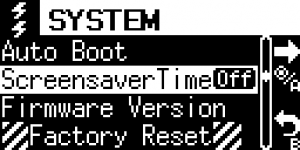
Note the screensaver will only be activated on the main status screen. The screensaver will not be activated when screens other than the main status screen, such as the menu or delivery status, are being displayed.
Connecting network
Network requirements
To use this product, a network connection that complies with the following requirements is necessary.
The network must be able to communicate with the Internet using IPv4, IPv6, or both.
Operation on a closed network environment is also possible, but there may be restrictions to use some functions.
IPv4 can receive an assigned IP address from DHCP and IPv6 can receive an assigned IP address through router advertisement.
For IPv4 only, a fixed address can be set manually.
At least the following ports must be connectable.
80/tcp and 8080/tcp (used by web application in this product)
1935/tcp (when using RTMP)
443/tcp (when using RTMPS)
554/tcp (default port for RTSP server in this product)
There are additional requirements when connecting to two different networks at the same time or when using a mobile network. For details, please refer to the relevant section.
Network connection
To use this product, it must be connected to a network that meets the requirements. The following patterns are available for network connection. Select the appropriate connection type according to the network environment in which this product will actually be used.
Connecting via Ethernet
This is a connection method in which this product is connected to the network via Ethernet.
+-------------------+
| |
| |
| USB (not used) |
1000BASE-T | |
Local area network | |
+---------| LAN |
| | |
+-------------------+ | | |
| | | +-------------------+
| Router |---------+ LiveShell W
The Internet <----| with |
| switch ports |---------+
<-- Outgoing | | | +-------------------+
<-- RTMP stream +-------------------+ +---------| Web browser |
+-------------------+
Laptop PC for LiveShell Studio
Connect the Ethernet LAN port (1000BASE-T Gigabit Ethernet interface) of the main unit to an Ethernet switch or other device using an Ethernet cable.
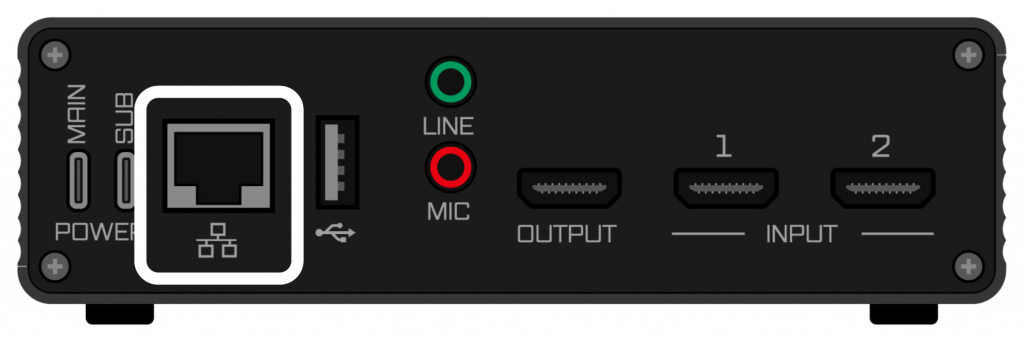
The default IP address is not set by factory default. The IPv4 setting is automatically obtained by DHCP, and the IPv6 setting is automatically obtained by router advertisement. If you need to set the IP address manually on a network where DHCP or router advertisement is not available, please refer to "Connecting to LiveShell Studio using wireless LAN access point mode" for details.
→ Connecting to LiveShell Studio using the wireless LAN access point mode
→ Connect to LiveShell Studio
Connecting via wireless LAN
This is a connection method in which this product is connected to a network via a wireless LAN. This product can only be connected in infrastructure mode.
+-------------------+
802.11 | |
Wireless network | |
[WLAN]=| USB |
~~~~ | |
+-------------------+ ~~~~ | |
| | ~~~~ | LAN (not used) |
| Router | ~~~~ | |
The Internet <----| with | ~~~~ | |
| Wireless AP | ~~~~ +-------------------+
<-- Outgoing | | ~~~~ LiveShell W
<-- RTMP stream +-------------------+ ~~~~
~~~~ +-------------------+
~~~~ | Web browser |
+-------------------+
Laptop PC for LiveShell Studio
Connect a wireless LAN adapter to the USB port on the rear side of the main unit.
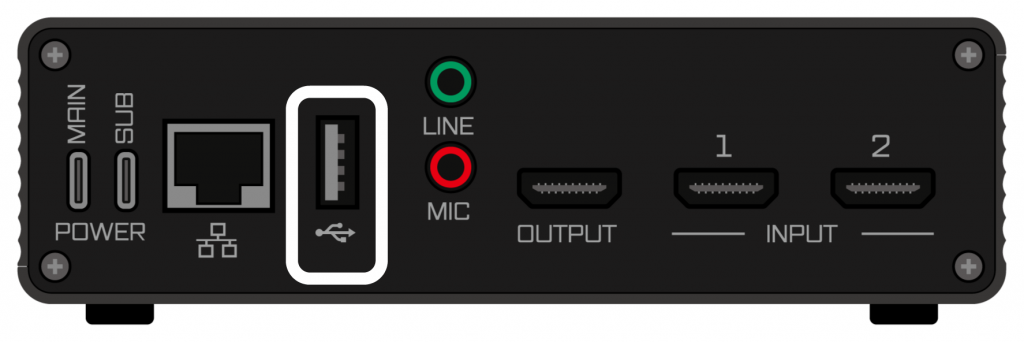
When using this product for the first time or when connecting to a different wireless network from the one already set up for this product, it is necessary to set the information (SSID and passphrase) for the wireless network to be connected to at first. This configuration must be done by connecting to LiveShell Studio using a PC or such. To connect to LiveShell Studio, connect this product to the network via wired LAN, or connect to LiveShell Studio using wireless LAN access point mode, and then process the settings.
→ Connecting to LiveShell Studio using the wireless LAN access point mode
→ Connect to LiveShell Studio
Using LiveShell Studio, you can configure your wireless LAN network settings by following steps
Click "Settings" button on the upper left of the LiveShell Studio
Select the "Network Settings" tab on the screen that appears.

Select "Wireless LAN" from the "Network Primary" pull-down menu.

Enter the SSID and the passphrase of the wireless LAN network you are connecting to in the "SSID" and "Passphrase" fields under "Wireless LAN Network" (enter the SSID to be used connecting as a client, not the SSID in AP mode).
Uncheck "Enable Wireless LAN AP Mode" in "Wireless LAM AP Mode".
Click "Save and Restart.
Connecting to both Ethernet and wireless LAN
This product can use both Ethernet and wireless LAN connections at the same time. In this case, connect to the network according to the respective items for Ethernet and Wireless LAN connections, and then set the "Network Primary" appropriately according to the type you use. The network primary setting has the following effects on how to select the IPv4 default gateway when communicating outside the IPv4 subnet to which this product is connected.
When the network primary is Ethernet
The gateway that can be reached from Ethernet is used preferentially, and the gateway that can be reached from the wireless LAN is used only when there is no gateway via Ethernet. Normally, the wireless LAN can communicate only with hosts in the same subnet. This configuration is suitable for the following usage patterns.
Configuration example: Operate LiveShell Studio from a PC connected wireless LAN and live streaming using LiveShell W Ethernet connection method.
<--- Monitoring Only Subnet --->
+-------------------+
~~~~ | Web browser |
+-------------------+ ~~~~ +-------------------+
| | ~~~~ Laptop PC for LiveShell Studio
| | ~~~~
| Wireless LAN AP | ~~~~
| | ~~~~
| | ~~~~ +-------------------+
+-------------------+ ~~~~ | |
~~~~ | |
[WLAN]=| USB |
| |
| |
+---------| LAN (Primary) |
<-- Outgoing +-------------------+ | | |
<-- RTMP stream | | | | |
| | | +-------------------+
The Internet <----| Router |---------+ LiveShell W
| |
| |
+-------------------+
Default gateway for LiveShell W
<--- Production Subnet --->
When the network primary is a wireless LAN
The gateway reachable from the wireless LAN interface is used preferentially, and the gateway reachable from the Ethernet interface is used only when no gateway exists on the wireless LAN interface. Normally, the Ethernet interface side can communicate only with hosts in the same subnet. This configuration is suitable for the type of use shown in the figure below.
Configuration example: Operate LiveShell Studio from a PC connected Ethernet and live streaming using wireless LAN connection method.
<--- Production Subnet --->
<-- Outgoing +-------------------+
<-- RTMP stream | |
| Router |
The Internet <----| with | ~~~~
| Wireless AP | ~~~~
| | ~~~~ +-------------------+
+-------------------+ ~~~~ | |
Default gateway for LiveShell W ~~~~ | |
[WLAN]=| USB (Primary) |
| |
| |
+---------| LAN |
| | |
+-------------------+ | | |
| | | +-------------------+
| |---------+ LiveShell W
| GbE Switch |
| |---------+
| | | +-------------------+
+-------------------+ +---------| Web browser |
+-------------------+
Laptop PC for LiveShell Studio
<--- Monitoring Only Subnet --->
Connecting to LiveShell Studio using the wireless LAN access point mode
If this product cannot be connected to your existing network infrastructure via Ethernet or wireless LAN, you can use the wireless LAN access point mode to connect to LiveShell Studio.
What is the wireless LAN access point mode?
The wireless LAN access point mode is an operating mode in which this product's wireless LAN adapter acts as a wireless LAN access point. By connecting a PC or other device used to operate this product as a terminal to the wireless LAN network provided by this access point, temporary connectivity can be set up to operate this product even when this product’s network settings have not been completed.
Operating conditions for the wireless LAN access point mode
To use the wireless LAN access point, this product must be booted with the wireless LAN adapter connected to the USB port on the rear side of the main unit. Note the wireless LAN access point mode and the function to connect this device to a wireless LAN network as a wireless LAN port (→ Connecting via wireless LAN) are used exclusively. Operating the wireless LAN access point mode does not affect Ethernet functionality.
How to activate the wireless LAN access point
To activate this product's wireless LAN access point function, use the control dial on the main unit as follows
Unit Main Menu / MAIN MENU → Network → AP Mode → Select AP Mode On and confirm.

How to connect to a wireless LAN access point
Unit Main Menu / MAIN MENU → Network → View AP Info

Using SSID and password shown on this screen, you can configure the wireless LAN settings of your operating computer, etc., and the device can be connected via wireless LAN. After connecting to the wireless LAN network, an IPv4 address will be assigned to the device from the IPv4 subnet 10.0.0.0/24 space via DHCP. You can connect to LiveShell Studio from your web browser, http://10.0.0.1/.
Connect to LiveShell Studio
About LiveShell Studio
LiveShell Studio is a web application built into this product. This product is designed to be operated mainly by using LiveShell Studio. The following is an example of operations that can be performed using LiveShell Studio.
Settings
Video resolution settings
Encoder bitrate and other settings
Network connection status and settings
Video target settings
Configuration of video compositing method
Monitoring and operation
Preview of video received via HDMI input
Apply video compositing and switching operations
Audio level control using audio mixer
Start and stop live streaming
Connect to LiveShell Studio
The steps to connect to LiveShell Studio are as follows
Confirm the URL of LiveShell Studio
First, confirm the URL of LiveShell Studio and user name and password for login from the menu of the main unit. The procedure is as follows:
Press the control dial on the main status screen to display MAIN MENU.
In MAIN MENU, press the control dial to select "Network" to display the NETWORK menu.

In NETWORK menu, press the control dial to select "Web Login".

WEB LOGIN screen will display the necessary information connecting to LiveShell Studio.
If the network connection of this product is not properly connected, the URL will be blank. In this case, please refer and check the network setting on Network connection section (→ Connecting network).
For some reason if this product cannot be connected to an existing network infrastructure, you can use the wireless LAN access point mode to connect an operating PC or other device (→ Connecting to LiveShell Studio using the wireless LAN access point mode).
Connecting to LiveShell Studio from a web browser
To connect to LiveShell Studio from a web browser, follow the steps below.
Connect your PC, tablet, smartphone, etc. (hereinafter referred to as "terminal for operation") to the same subnet to which this product is connected.
Start a web browser on the terminal for operation, and enter the URL confirmed in the WEB LOGIN screen of the previous section in the URL field.
If you connect to LiveShell Studio, you will be asked to enter your user name and password. Enter the information you confirmed on the WEB LOGIN screen.
If the authentication succeeds, the LiveShell Studio application screen will appear in your browser.

Basic operation with LiveShell Studio
With LiveShell Studio, you can configure and operate this product, such as comprehensive settings, real-time live preview from the input source, and manipulate video and audio. This section describes the basic operations.
Configuration of this product by using LiveShell Studio
By clicking "Settings" in the upper left corner of the LiveShell Studio, this product's settings screen will appear.
→ System settings
→ Network settings
LiveShell Studio language setting
From "言語/Language" pull-down nemu in the upper right corner of the LiveShell Studio, you can switch the language to English or Japanese.
Real time live viewing from the input
The left half of the LiveShell Studio screen is for "preview” area where thumbnails of the video from the two HDMI inputs are displayed in real time. In the preview area, you can visually manipulate video switching and video compositing settings.
→ Video switching
→ Video manipulation
Real time live viewing from the program output
The right half of the LiveShell Studio screen is for the "program” area, where images from the program output are displayed at "PGM OUT". The audio is not automatically played, but it can be heard by unmuting it in the browser (the unmuting method varies from browser to browser, but in general, right-click to bring up the controls). In this area, you can also change live streaming target settings and start or stop streaming.
Real time live viewing restrictions
The following restrictions apply to the video displayed as real time live viewing.
The thumbnails on the preview screen will continue to display the last frame shown when signal reception from the HDMI is interrupted.
Thumbnails may not be displayed correctly if the HDMI format recognition does not match the video reception status.
The video and audio in the program output are generated by playing back the same stream as the streaming, so there is a delay compared to the input video thumbnail. There is also a delay with the movement of the audio level meter.
Safari and iOS browsers display a simulated video by combining thumbnails. This simulated video has the following limitations.
It does not exactly match the actual program output.
Video effects such as Mix and Wipe are not reproduced.
Chroma key is not reproduced.
Audio will not be outputed.
Monitor output (→ Video monitor output connection)or RTSP server function is available for the monitoring the program output.
Detailed operations for video and audio
At the bottom of the preview and program screens, there is a various operation area. There are tabs for specific functions and settings, such as "Composition", "Audio" and "Encoder”. By clicking on these tabs, comprehensive settings and operations are possible. In addition, clicking on the "Message" tab will show messages about the operation.
→ Video manipulation
→ Caption/Overlay image
→ Audio mixer opration
→ Video encoder settings
System settings
This section describes the initial setting setup.
System video format
Unit Main Menu / MAIN MENU → Encoder → Resolution
LiveShell Studio / Settings → Device Settings Tab → System Video Format
Factory Default / 1920x1080 60p
"System Video Format" is used to determine the format (number of pixels, frame rate and interlaced or not) of the video signal input to this product. The system video format can be selected from one of the following.
1920x1080 60p
1920x1080 50p
1920x1080 30p/60i
1920x1080 25p/50i
1920x1080 24p
1280x720 60p
1280x720 50p
1280x720 30p
1280x720 25p
1280x720 24p
720x576 24p
720x480 60p
640x480 60p
The format of the video input to HDMI INPUT 1 and HDMI INPUT 2 must be the same as the system video format setting. Inputting video in a different format from the system video format may cause problems such as video not being recognized or video not being played properly. Be sure to check that they are the same.
When 1920 x 1080 30p/60i or 1920 x 1080 25p/50i is selected as the system video format, interlaced video can be input. When interlaced video is input, this product treats it as a progressive video equivalent to half the frame rate of the original video by doing de-interlaced it from 60i to 30p or 50i to 25p.
The resolution and frame rate of the stream output by the video encoder are also be the same as the system video format. If the system video format is changed during operation of this product, the streamed video may be disturbed. In this case, please reboot this product.
Clock setting
Unit Main Menu / Not available
LiveShell Studio / Settings → Device Settings tab → Clock
Factory Default / None
This setting is used to manually set the date and time on this product's built-in clock. By clicking "Set the device clock to your PC" button, it will set this product's clock to the same date and time as the clock of the PC or device browser is running. In addition to this method, this product's clock can also be synchronized with an NTP server using the Network Time Protocol (→ NTP server address setting).
The time set here will appear on the unit's display.
Time zone setting
Unit Main Menu / Not available
LiveShell Studio / Settings → Device Settings tab → Time zone
Factory Default / UTC
This setting is used to set the time zone for the clock built into this product.
Automatic boot setting
Unit Main Menu / MAIN MENU → System → automaticBoot
LiveShell Studio / Settings → Device Settings tab → Automatic boot
Factory Default / OFF
This setting is used to determine whether or not this product will automatically boot when a power supply is connected to this product. When automatic boot is set to ON, this product will start up even if the power button is not pushed. When automatic boot is turned OFF, this product does not start up by connecting a power supply to this product, but boot after the power button is pushed.
Device name setting
Unit Main Menu / Not available
LiveShell Studio / Settings → Device Settings tab → Device name
Factory Default / LiveShell W
This setting is used to name each this product. The name set here is only displayed on the banner of LiveShell Studio and does not affect the operation of this product. It is possible to set a name that is easy to distinguish when handling multiple this product at the same time. The initial name is set to "LiveShell W".
Network settings
Network primary setting
Unit Main Menu / MAIN MENU → Network → Primary Net
LiveShell Studio / Settings → Network Settings tab → Network Primary
Factory Default / Ethernet
This setting is used to determine which network interface's default gateway is for the network primary when this product has multiple network interfaces. For details on the specific operation according to the setting, please refer to Connecting to both Ethernet and wireless LAN.
Ethernet IP setting
Unit Main Menu / Not available
LiveShell Studio / Settings → Network Settings tab → Ethernet IP
Factory Default / Automatic (DHCP)
This is setting for the IPv4 address which to be given to this product's Ethernet LAN Interface. The following settings are available.
IPv4 setting
You can select either Automatic (DHCP) or Fixed. If "Fixed" is selected, the following items can be further configured:
IPv4 address
Subnet mask
Default Gateway
Wireless LAN network settings
Unit Main Menu / Not available
LiveShell Studio / Settings → Network Settings tab → Wireless LAN Network
Factory Default / Not setted
This is the setting for the wireless LAN network to which the wireless LAN adapter will be connected to the USB port of this product.
SSID
Passphase
Wireless LAN IP setting
Unit Main Menu / Not available
LiveShell Studio / Settings → Network Settings tab → Wireless LAN IP
Factory Default / Automatic (DHCP)
This setting is used to set an IPv4 address to be assigned to the wireless LAN interface when a wireless LAN adapter is connected to the USB port of this product. The following settings are available.
IPv4 setting
You can select either Automatic (DHCP) or Fixed. If "Fixed" is selected, the following items can be further configured:
IPv4 Address
Subnet mask
Default Gateway
DNS server setting
Unit Main Menu / Not available
LiveShell Studio / Settings → Network Settings tab → DNS Server
Factory Default / Automatic (DHCP)
You can select "Automatic" or "Fixed" for the DNS server setting referenced by this product. When "Automatic" is selected, the value obtained by DHCP is used. When "Fixed" is selected, the following items can be further configured.
Primary DNS server
Secondary DNS server
NTP server address setting
Unit Main Menu / Not available
LiveShell Studio / Settings → Network Settings tab → NTP server address
Factory Default / Not setted
This setting is used to set the NTP server setting used when synchronizing the main unit clock of this product with the Network Time Protocol. Leave this blank if you do not wish to synchronize. The main unit clock can also be set manually (→ Clock setting).
Video and audio outputting/outputting
HDMI source input
This product can receive two HDMI video signals as video sources. In addition, the audio signals superimposed on each HDMI are connected to the audio mixer inside the device as two digital audio inputs.
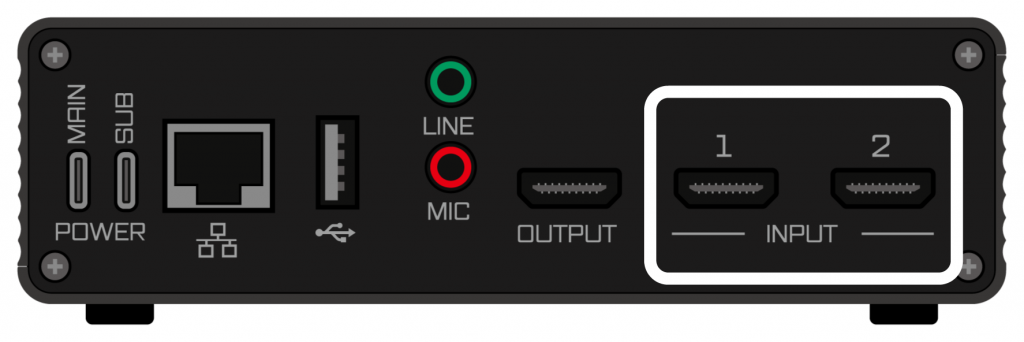
HDMI signals must be connected to the HDMI 1 and HDMI 2 ports; the HDMI video format must match the system video format (→ System video format). If only one video source is to be input, connect to the HDMI 2 port and leave the HDMI 1 port unconnected.
The video being received by LiveShell W can be viewed and checked by LiveShell Studio's thumbnail (→ Real time live viewing from the input).
HDMI audio input requirements
The HDMI audio signal requirements that this product can receive are as follows. Surround audio and compressed audio cannot be received.
Linear PCM 2-channel (stereo) audio
Sampling rate of 48 kHz / 44.1 kHz / 32 kHz
Analog audio source input
There are two analog audio source inputs: LINE input and MIC input.
For LINE input, Line-level stereo analog audio signals can be connected.
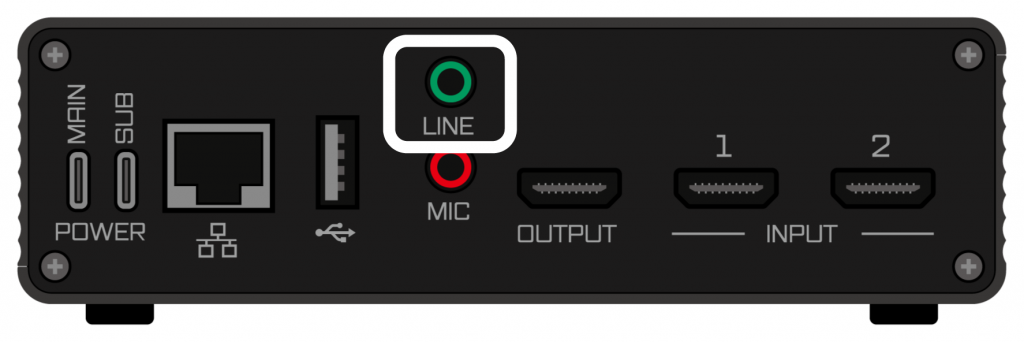
The MIC input is connected to the internal preamp and allows direct connection of a microphone.
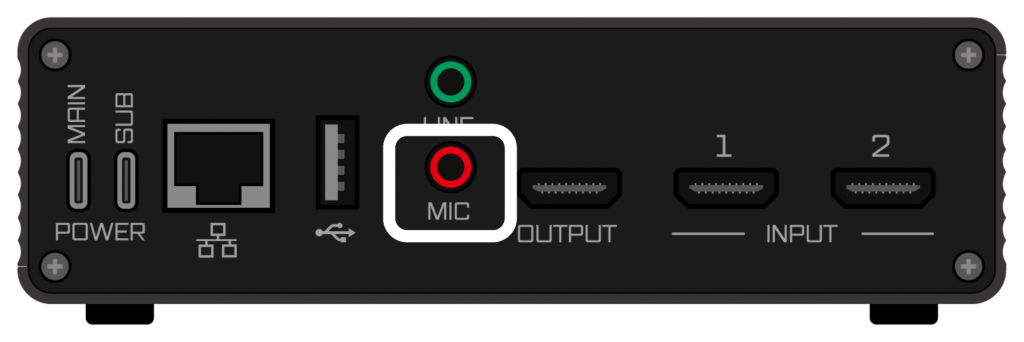
The analog audio input is connected to the audio mixer inside the device and can be mixed with the digital audio input.
USB audio source input
By connecting a USB audio class device to the USB port on this product, the input channels of the device can be input to the audio mixer on this product.
The USB audio class device that can be used is one that can be set to 48 kHz 16 bit sample format and has one input source. Operation when a device with multiple sources connected is undefined. Also, connectivity with all devices is not guaranteed.
Video monitor output connection
HDMI OUTPUT outputs a program video identical to the live video stream, allowing you to monitor the streamed program video by connecting a display monitor capable of HDMI signal input to HDMI OUTPUT. The output format of the HDMI OUTPUT is the same format as the system video format (→ System video format). Depending on the display monitor, it may not be possible to display video in the format output from HDMI OUTPUT. Please check the specifications of the display monitor thoroughly. In particular, some computer displays monitors may not be able to display images in 30p, 25p, etc.
USB audio source output
By connecting a USB audio class device to the USB adapter port of this product, the output channel of the device can be used as the audio monitor output of this product. The audio output as a monitor is the same as the master output.
The USB audio class devices that can be used are those that allow the sample format to be set to 48 kHz 16 bit and have a single output sink. Operation when a device with multiple sinks is connected is undefined. Also, connectivity with all devices is not guaranteed.
Video maniplulation
This product can input two different video signals at the same time, and outputs video with one of the following processes performed on these two images.
Selecting only one of the two video signals
→ Video switchingCompress one of the two videos and merge it on top of the other one.
→ Picture-in-picture (PinP)split the screen into left and right and put the two videos side by side.
→ Screen splitClip the video shot with the green background and merge it on top of the other video.
→ Chroma key
The following effects can also be added to the output video if desired
Composite a still image on top of the video image.
→ Caption/Overlay image.
This chapter describes how to perform these operations.
Video switching
Switching is a mode in which only one of the video inputs, either input A or input B, is selected for programmed output. Switching can be operated with either the video select button on the main unit or LiveShell Studio.
Switching operation by the unit operation
The video select buttons on the unit of this product allow switching of video signals. When "A" of the video select button is pressed, the program output switches to the video of Input A. When "B" is pressed, the program output switches to the video of Input B. When switching is performed using the video select button, the video effect at the time of switching is applied with a MIX transition time of 1 second.
Even when Picture-in-Picture, Split or Chroma-Key is applied by using LiveShell Studio, pressing the video select button on the unit will cancel the composition and the selected input will be the program output.
Switching operation using LiveShell Studio
To perform switching by LiveShell Studio, proceed as follows:
Select "Switching" from the slider at the top of the preview screen.
Click the desired switching destination on the preview screen (Input A or Input B) with the mouse. When clicked, the relevant screen will be displayed as "Selecting". The following is an example of preparing to switch to Input B when Input A is used as program output.
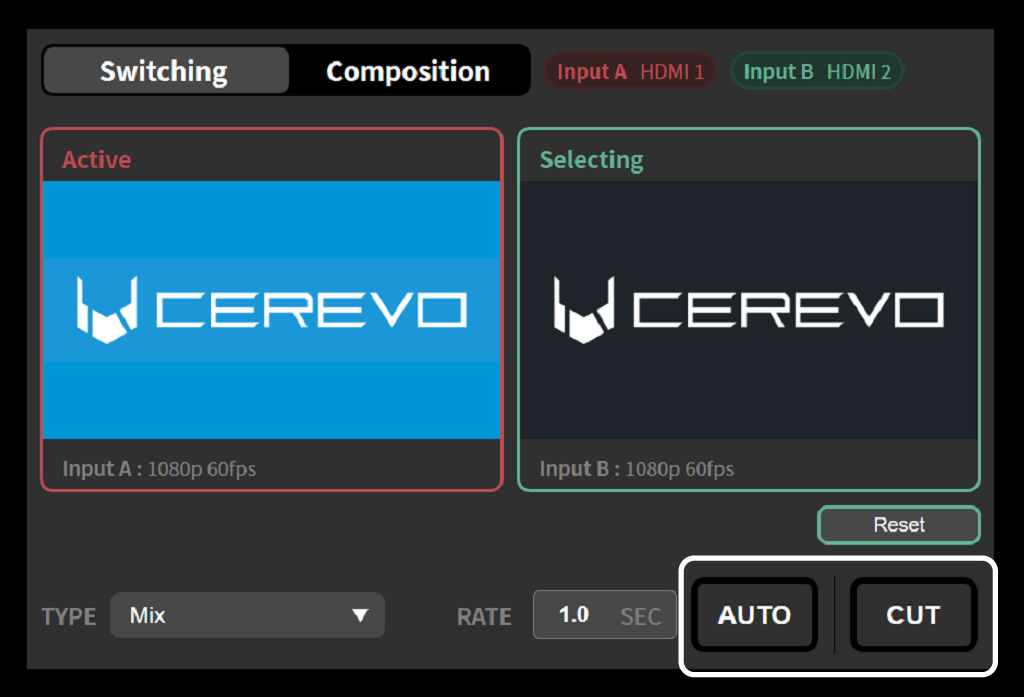
Clicking the AUTO or CUT button with the switching destination selected switches the program video output to the currently selected input The differences between AUTO and CUT are as follows.
AUTO applies the video effect specified by TYPE at the time set by RATE (→ Selecting video effects for switching).
CUT immediately switches the video without applying any effects.
Selecting video effects for switching
Video effects can be applied for smooth video switching. The effect to be applied can be selected from the TYPE pull-down menu. There are two types of video effects: Mix and Wipe.
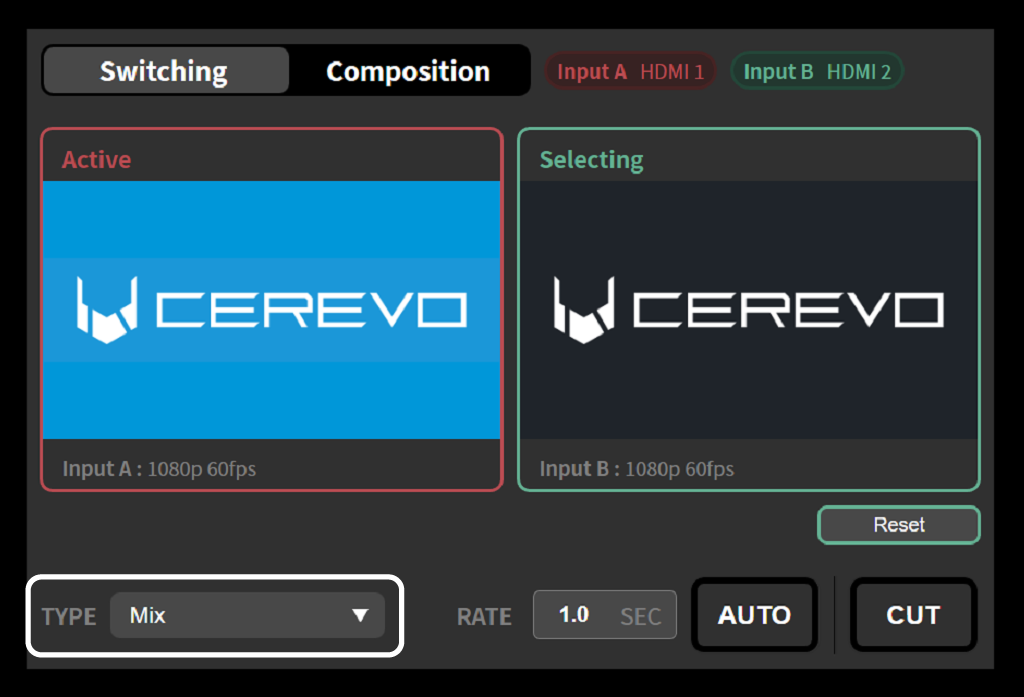
Mix
Smoothly transitions between two images while combining them by fading.
Wipe
Splits the screen and transitions between two images while moving the dividing line. Depending on the direction of movement of the dividing line, the following four types can be selected.
Wipe (from let to right)
Wipe (from right to left)
Wipe (from top to bottom)
Wipe (from bottom to top)
Specifying the transition time for video effects
The transition time for Mix and Wipe can also be specified by entering the time in seconds in the "RATE" field. The default value is 1.0 second.
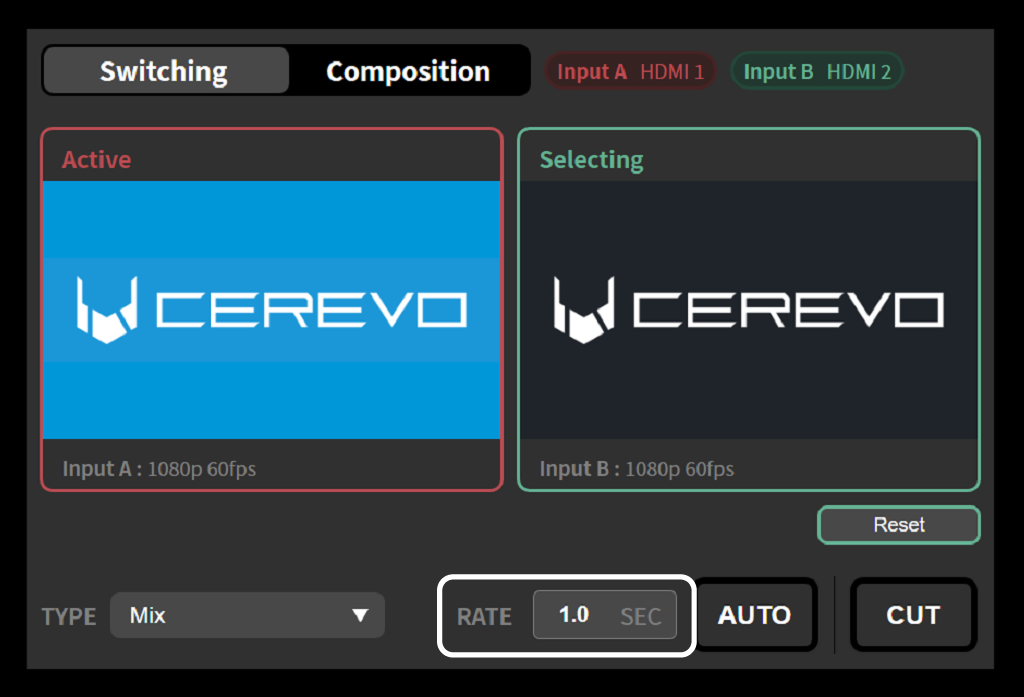
Video manipulation
This product can synthesize two video inputs, Input A and Input B, into a program output. To use the video manipulating function. Select "Composition" from the slider at the top of the preview screen, then select the compositing method to be applied from "PinP," "Split," or "Chroma Key" on the left side of the preview screen.
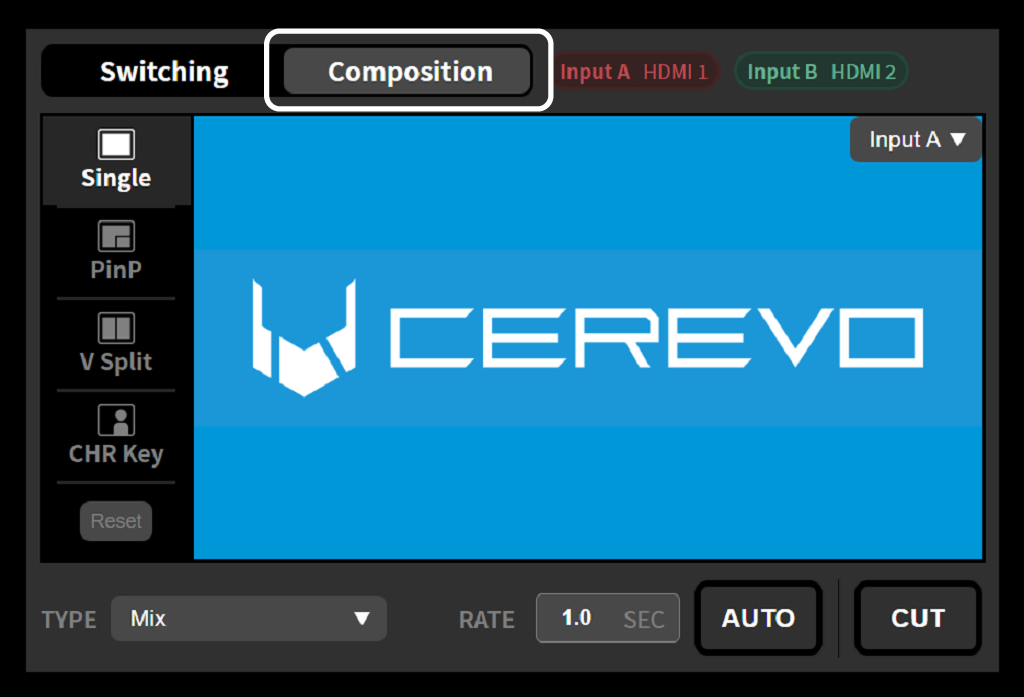
Picture-in-picture (PinP)
Picture-in-picture (PinP) is a feature that overlays a different, scaled-down sub-screen on top of the input that serves as the main screen. To use PinP, operate as follows;
Select "PinP" from the left side of the preview screen.
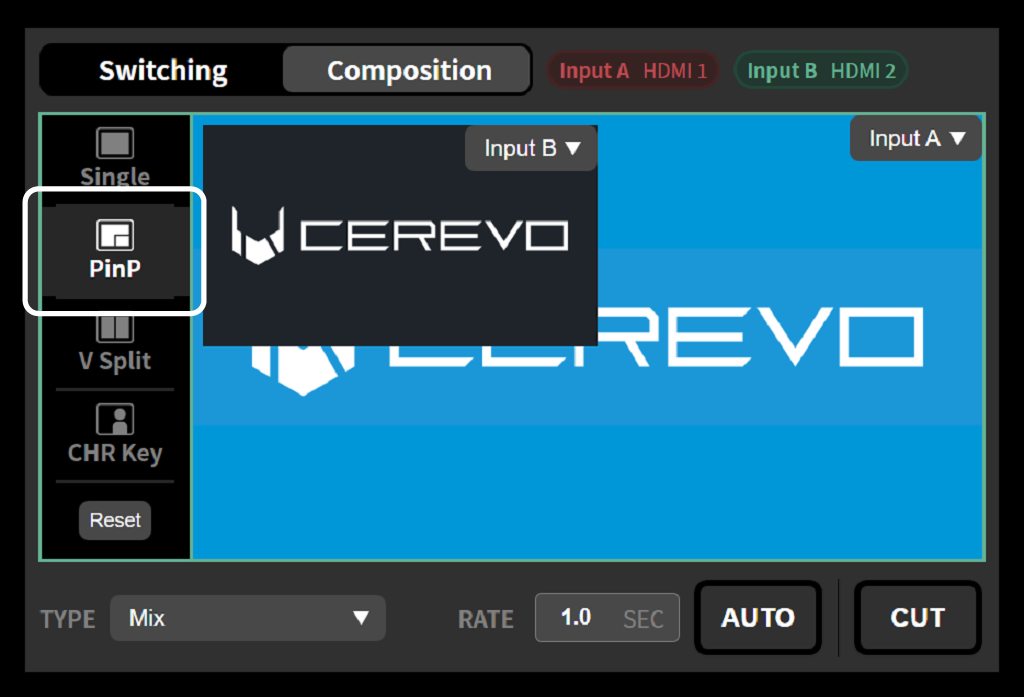
Select "Composition" from the tab at the bottom of the preview screen.
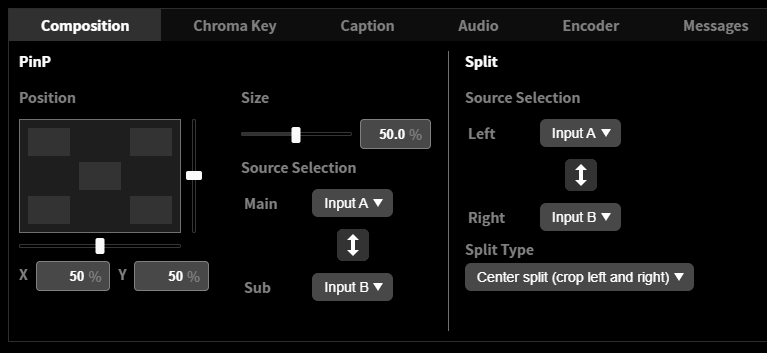
Select the input to be used as the main screen and the input to be used as the sub-screen from the "Source Selection" pull-down menu for "PinP" in the Composition tab. You can also select the main screen and the sub screen from the pull-down menu displayed within the preview screen.
Select the position where you would like to composite the sub screen from the "Position" of "PinP" in Composition tab by clicking on it.
Select the size of the sub screen from the "Size" pull-down menu of "PinP" in Composition tab. After making a selection, the composite position can be fine-tuned by operating the vertical and horizontal sliders.
Click AUTO or CUT button in the preview screen to switch the program video output to the composite video you have set.
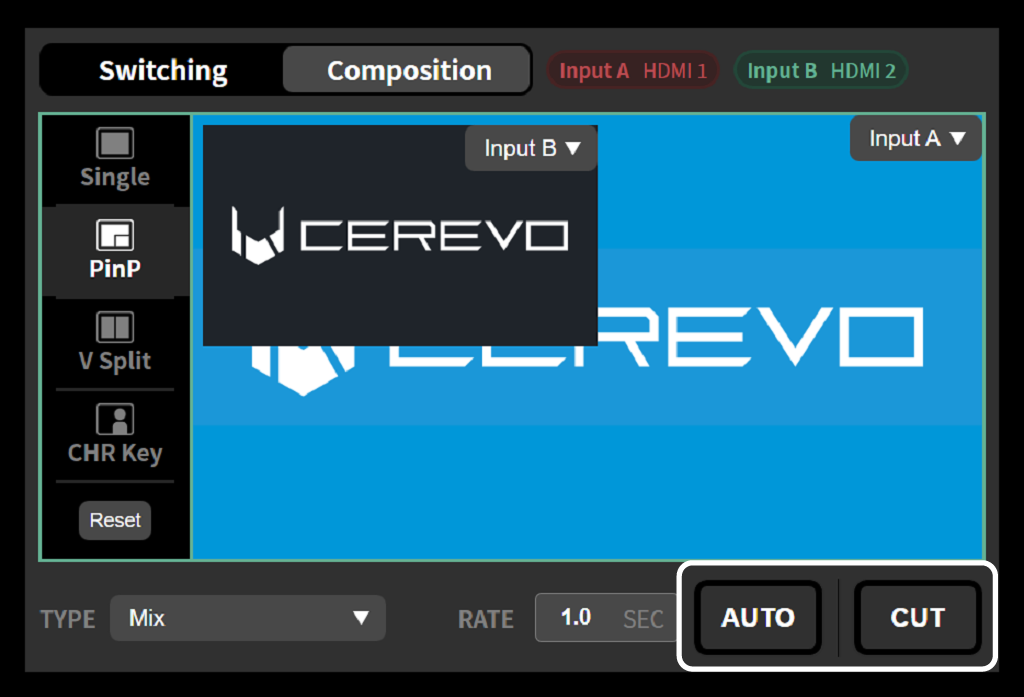
Screen split
Split screen is a composite method in which a portion is cut from two video inputs and placed side by side on the left and right. You can select from one of the following methods to cut out a portion of the video.
Center split (left-right crop)
Center split (center crop)
Seminar mode (4:3 left side)
Seminar mode (4:3 right side)
Seminar mode (16:9 left side)
Seminar mode (16:9 right side)
Center Split splits the video in the center and places the two images on the left and right sides of the dividing line, respectively. There are two ways to crop the video. If you select "Left/Right Crop," the left and right halves of the original video are cropped and used as the source for compositing. If you choose "Center Crop," the center of the original image will be cropped and used as the source for the composite.
The seminar mode is suitable for placing the slides and the speaker's image on the left and right sides of the screen. 4:3 option combines 4:3 sized slides and a center-cropped image of the speaker on a 16:9 screen area. 16:9 option combines a slightly reduced 16:9 sized slide and a center-cropped image of the speaker on a 16:9 screen area. The 16:9 option combines a slightly scaled-down 16:9 slide with a center-cropped image of the performer on a 16:9 screen area. You can also choose to place the slides on the right or left side of the screen, respectively
To use this function, operate as follows.
Select "Split" from the left side of the preview screen.
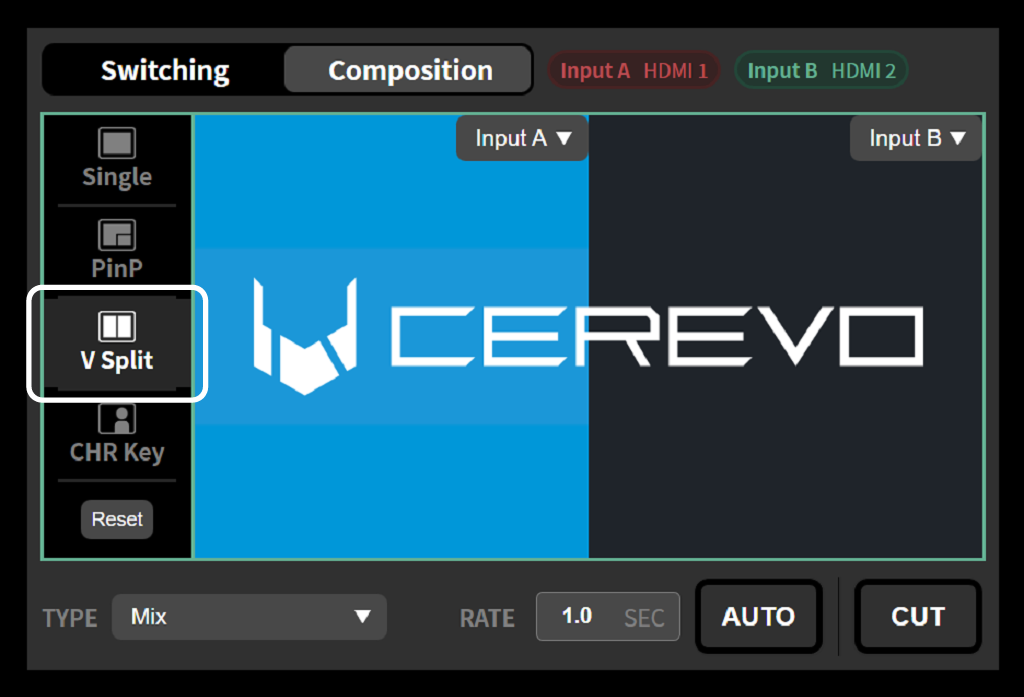
On the preview screen, select the input to be used as the left half of the image and the input to be used as the right half of the image.
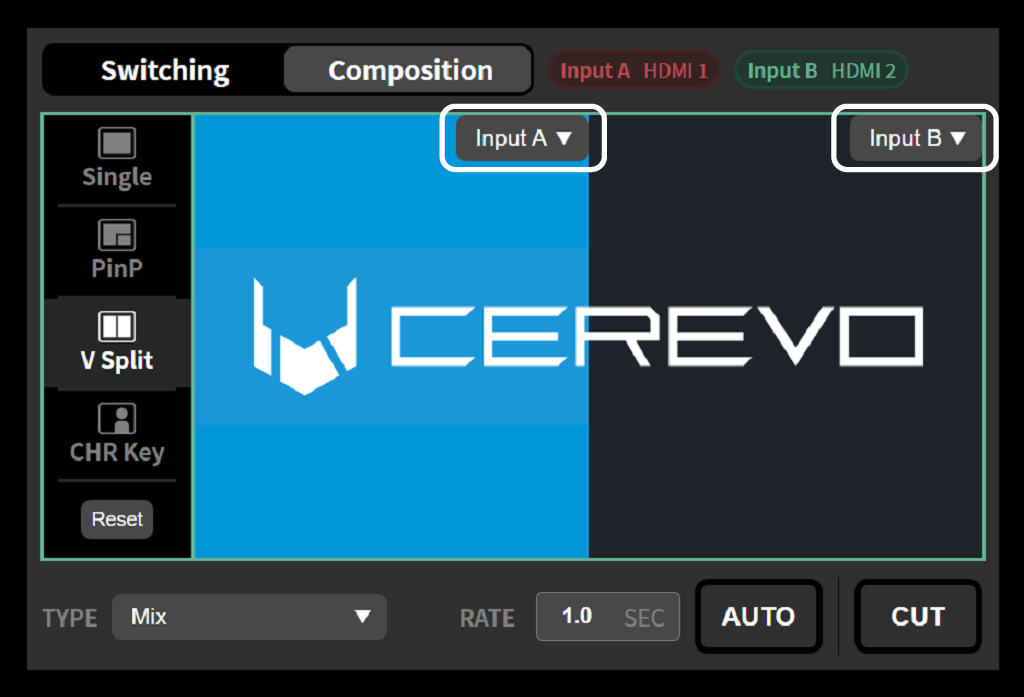
Select "Composite" from the tab at the bottom of the preview screen. Select "Split Type" from "Split" on this tab.

Clicking the AUTO or CUT button in the preview screen switches the program video output to the composite video you have set.

Chroma key
Select "CHR Key" from the left side of the preview screen.

Select "Chroma Key" from the tab at the bottom of the preview screen.
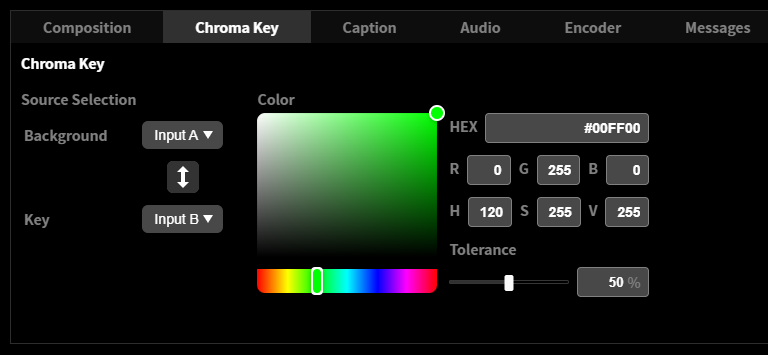
Select the input to be used as the main screen and the input to be used as the sub screen from the "Source Selection" pull-down menu for "Chroma Key" in Composition tab. You can also select the main screen and the sub screen from the pull-down menu displayed in the preview screen.
Use the color picker to select a key color to be made transparent. Also, use the "Error Range" slider or enter a numerical value to specify a range of similar colors to be recognized as the key color Use the "Error Range" slider or enter a numerical value.
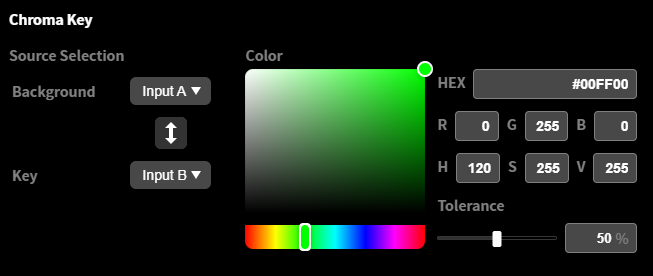
Clicking the AUTO or CUT button in the preview screen switches the program video output to the composite video you have set.

Selecting key color for chroma key
The chroma key function of this product can be used effectively for color elements where one of the three primary colors of light (red/blue/green) is predominant and the brightness is generally uniform. Colors that are composite (e.g., yellow) cannot be clipped well.
If the brightness of the key color is low, good cropping will not be possible.
To select the key color, refer to the thumbnail image and select a color that is as bright as possible in the color gamut to be used as the key color.
The error range should be within 50%, otherwise unintended colors may be recognized as the key.
The chromakey composition is not displayed on the preview screen; adjust it while viewing the HDMI OUT program output or the streaming image.
Image effects when compositing images
When manipulating video, video effects during switching can be applied only in the following combinations. Video effects are not applied when switching between different composite modes.
Transition between no mix and PinP
The Mix effect can be applied only when transitioning between the same input and the input used as the main screen in PinP. Other effects will be disabled even if selected.
Transition between no composite and split
Only Wipe can be used to transition between no composite and the split. Regardless of the wipe direction specified, the wipe will be in the direction that is actually applicable according to the input to which it is being switched.
Transition between no composite and chroma key
The Mix effect can be applied only when transitioning between the same input and the input used as the background screen for chromakey. All other effects will be disabled even if selected.
Caption/Overlay image
This function allows you to composite a still image or text onto the program output video. This can be used to display a message to the viewer or a logo. Text and image can be used at the same time and text only caption can be used.
The caption/overlay image must be created in advance using image editing software.
Images for caption/overlay image
Images must be created in advance using image editing software, etc., and uploaded to this product's memory in LiveShell Studio. Images that meet the following conditions can be used in the feature.
The file format must be a 24-bit color PNG image.
Interlaced PNGs are not supported.
The recommended image resolution is the same as the system video format (→ System video format).
For example, if the system video format is set to 1920 x 1080 60p, the caption/overlay image size should be 1920 x 1080 pixels. If the system video format is set to 1280 x 720 60p, the image size should be 1280 x 720.
The file size must be less than 2 megabytes.
For PNGs with an alpha channel, composite according to transparency. You can composite just the logo or get an effect like a semi-transparent watermark.
How to upload a caption/overlay image
To upload an image to be used as a caption/overlay to this product's memory is as follows. You can save up to 4 caption/overlay images at the same time.
Select "Caption" from the tab at the bottom of the preview screen.

Click "Upload" and select the prepared file. This will save the selected image in this product.

The caption/overlay image saved in this product will be displayed as a thumbnail as shown below.

How to composite a caption/overlay image
To composite an uploaded image into program output, follow the steps below.
Click on the thumbnail of the caption/overlay image you wish to apply to make it selected.

Click the "Apply" button in the lower right corner.
If you are already compositing a caption/overlay image and you select another to apply, it is to be composited will switch to the newly selected caption/overlay image. To stop compositing an caption/overlay image, follow the steps below.
Click "OFF" on the left side of the caption/overlay thumbnail.

click the "Apply" button on the lower right.
How to delete a caption/overlay image
To delete an uploaded image, click the "Delete" button below the thumbnail of the caption/overlay image you wish to delete. Once deleted, it is cannot be retrieved.
How to insert a caption/overlay image
The procedure to insert a caption/overlay image into program output is as follows.
Select "Caption" from the tab at the bottom of the preview screen.

Enter the text you wish to display in "Text 1" or "Text 2" or both. Up to two text strings can be set to be displayed.
Select the font you wish to use. There are restrictions on the fonts that can be used depending on the language.
Select the font size and the color. You can set the font color, background color, and border color and transparency separately. The color and transparency should be set in the format #RRGGBBAA with hexadecimal values from 00 to FF. Transparency is fully transparent at 00 and fully opaque at FF. The transparency value may deviate from the set value by 1 due to the rounding, but this is not abnormal.
To overlay an image or text, select one of the "Images" for the image to be pverlaied.
Click "Apply" to composite the caption into the program output.
How to delete a caption/overlay image
To delete an image or text, do the following.
Delete an image or text from "Text 1" or "Text 2" or both.
Click "Apply" to deleted the image or text in the program output.
Video encoder settings
The program output of this product is internally connected to an H.264 encoder, which compresses and converts video into a code suitable for network distribution. The following settings can be adjusted for the video encoder.
Video bitrate setting
Unit Main Menu / MAIN MENU → Encoder → Bitrate
LiveShell Studio / Main Menu / Encoder → Bitrate
Factory default / 8192 kbps
This is the setting for the average bitrate output by the H.264 encoder. Use an appropriate setting according to the recommended settings of the streaming platform and network bandwidth.
Video frame rate setting
Unit Main Menu / MAIN MENU → Encoder → Frame Rate
LiveShell Studio / Main Menu / Encoder → Frame Rate
Factory Default / Full
This is the setting for the number of frames per second output by the H.264 encoder. Use an appropriate setting according to the recommended settings of the live streaming platform and network bandwidth. The following settings can be made for this product.
When the system video format is set to 60p or 50p
When set to "Full", the output frame rate is the same as the system video format (60 fps or 50 fps).
When set to “Half", the output frame rate is half the frame rate of the system video format (30 fps or 25 fps).
When the system video format setting is other than 60p or 50p
Only the "Full" setting is valid. The output frame rate is the same as that of the system video format.
Key frame rate interval setting
Unit Main Menu / MAIN MENU → Encoder → KeyFrameInterval
LiveShell Studio / Main Menu → Encoder → Key Frame Interval
Factory Default / 120
This is the setting for whether a key frame (I-Picture) is inserted in H.264 encorder's output frame. Use an appropriate setting according to the recommended settings of the live streaming platform and network bandwidth. Normally, the value is set sending out a frame once every 2 seconds (twice the frame rate value).
H.264 profile setting
Unit Main Menu / MAIN MENU → Encoder → H.264 Profile
LiveShell Studio / Main Menu → Encoder → H.264 Profile
Factory Default / High
This is the encoding profile setting used by the H.264 encoder. You can select from Baseline, Main, or High. Normally, set to High.
Audio mixer
This product is equipped with an audio mixer, which can mix digital audio signals from the two HDMI inputs as well as analog audio inputs from the MIC and LINE inputs. This chapter describes how to operate the audio mixer.
Audio mixer opration
The audio mixer can be operated using both the LiveShell Studio and the main unit control dial.
LiveShell Studio audio mixer

Audio mixer that can be operated with the control dial on the main unit
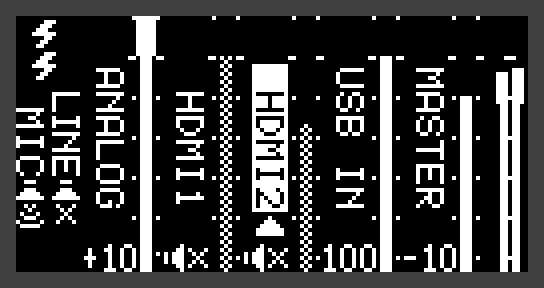
Analog audio input gain adjustment
Unit Main Menu / MAIN MENU → Audio → Analog Gain
LiveShell Studio / Main Menu → Audio Tab → Analog Input
Factory Default / 0 dB
This is the gain adjustment value of the variable gain amplifier for analog audio input (MIC input and LINE input). Possible range is from -4.5 dB to +6 dB.
Audio analog mute
Unit Main Menu / MAIN MENU → Audio → Mixer
LiveShell Studio / Main Menu → Audio Tab → Analog Input
Factory Default / Mute
Mute settings for individual MIC and LINE inputs among the analog audio inputs. In LiveShell Studio, clicking "ON" or "MUTE" button toggles the state. It is unmuted when the button shows "ON" and muted when it shows "MUTE".
When the MIC or LINE input is unmuted, the audio level meter floor may rise even when there is no input due to the noise floor of the input circuitry and amplifier. We recommend setting mute if you do not use the input. The factory default setting is mute.
AGC (automatic gain control) for analog audio input
Unit Main Menu / MAIN MENU → Audio → Analog AGC
LiveShell Studio / Main Menu → Audio Tab → Analog Input
Factory Default / AGC OFF
This setting determines whether AGC (Automatic Gain Control) is applied to the analog audio input. When AGC is enabled, in addition to the effect of automatically correcting the gain according to the input volume level, a denoiser is also enabled to reduce noise (especially white noise) in the input audio.
AGC is effective when a microphone is connected to record human speech. If it is applied to music or other sounds other than speech, oscillation, distortion, or other problems may occur. Also, if the input level is too high, oscillation or other problems may occur. In this case, lower the analog audio gain.
Level adjustment for each source
Unit Main Menu / MAIN MENU → Audio → Mixer
LiveShell Studio / Main Menu → Audio Tab → Audio Mixer
Factory Default / 0 dB
The attenuation value can be adjusted for each source, Analog, HDMI1, and HDMI2. The adjustment range is from 0.0 dB (no attenuation) to -∞ (total attenuation). This can be adjusted in LiveShell Studio using the slider with the mouse or by entering a value you wish.
"Analog" is an adjustment for mixed signals from the MIC and LINE inputs.
Mute per source
Unit Main Menu / MAIN MENU → Audio → Mixer
LiveShell Studio / Main Screen → Audio Tab → Audio Mixer
Factory default / ON (unmute)
You can set the input mute for each source (Analog, HDMI1, and HDMI2). In LiveShell Studio, clicking the "ON" or "MUTE" button toggles the state. When the button is in the "ON", the input is unmuted. When the button is in the "MUTE", the input is muted.
Analog is muted for mixed signals from the MIC and LINE inputs, and the MIC and LINE inputs can be muted separately (→ Audio analog mute).
Set to correct delay for each source
Unit Main Menu / MAIN MENU → Audio → Source Delay
LiveShell Studio / Uninstalled
Factory default / 0 ms
The correction can be set in milliseconds for each source (Analog, HDMI1, HDMI2, and USB IN). Supported values range is from 0 to 300 ms. The amount of this value will be the video lead relative to the standard timing.
HDMI audio AFV (Audio Follow Video)
Unit Main Menu / MAIN MENU → Audio → AFV
LiveShell Studio / Main Screen → Audio Tab → Audio Mixer
Factory default / OFF
AFV (Audio Follow Video) is a function that controls audio mute in conjunction with HDMI video switching. Turning AFV ON unmutes the audio of the HDMI input that is currently selected for switching. The audio of unselected HDMI inputs will be muted. AFV has no effect when other than switching (PinP, etc.) If the video transition time is set, the audio will crossfade at the same time.
Master volume control and mute
Unit Main Menu / MAIN MENU → Audio → Mixer
LiveShell Studio / Main Screen → Audio Tab → Audio Mixer
Factory default / 0 dB | ON (unmute)
Audio Master adjusts the level of the output audio after mixing. The operation method is the same as the level adjustment for each source. When the Master is muted, the output will be completely silent.
USB audio monitor output control and mute
Unit Main Menu / MAIN MENU → Audio → Mixer
LiveShell Studio / Main Screen → Audio Tab → Audio Mixer
Factory default / 0 % | ON (unmute)
This is the monitor audio level setting for output to USB audio. This setting is applied to the mixer of the relevant channel when a USB audio device with an output channel is connected. The adjustment and the volume level after adjustment depend on the specifications of the mixer device has. Also, some devices do not support volume adjustment or mute.
Audio encorder
The output of the audio mixer is internally connected to an AAC-LC encoder. It compresses the PCM audio signal and converts it to a code suitable for network distribution. The following settings can be adjusted for the audio encoder.
Audio bitrate setting
Unit Main Menu / MAIN MENU → Encoder → Audio Bitrate
LiveShell Studio / Main Screen → Audio Tab → Bitrate
Factory Default / 128 kbps
This is the audio bitrate setting for output by the AAC-LC encoder. Set this to a rate appropriate for a live streaming platform. Possible values range from 48 to 256 kbps. The sampling rate is fixed at 48 kHz and cannot be set.
Setting output audio delay
Unit Main Menu / MAIN MENU → Encoder → Audio Delay
LiveShell Studio / Main Screen → Audio Tab → Audio delay
Factory Default / 0 ms
This value is used to correct the gap between video and audio. It can be set in milliseconds. Possible values range from -300 to 300 ms. Negative values result in audio lead with respect to standard timing, while positive values result in video lead with respect to standard timing.
Target settings
This product can transmit encoded video and audio to an IP network and record them to a storage medium by configuring the target (streaming destination) settings. The target settings can be configured using LiveShell Studio. The target setting cannot be set using the main unit.
Overview of target settings
Target refers to the destination of the video and audio streams generated by this product's encoder, and can be broadly classified into two categories: network distribution and recording.
This product can send the same stream to up to three targets simultaneously. Therefore, this product can hold up to three different target settings that are active at any given time. On the other hand, there is no limit to the total number of target settings this product can store. For example, if there are seven targets stored in this product as shown in the figure below, any three of the seven targets can be enabled as the targets to be actually used. The enabled targets are specifically called "Channel".
Streaming Targets Targets selected as Channels
~~~~~~~~~~~~~~~~~~~~~~~~~~~~ ~~~~~~~~~~~~~~~~~~~~~~~~~~~~
Stream Target 1) ExampleTube ----------------> [ Channel 1 ]
Stream Target 2) RTSP Server +---------> [ Channel 2 ]
Stream Target 3) LiveExample | +-----> [ Channel 3 ]
Stream Target 4) Recording ------+ |
Stream Target 5) 5555-Video |
Stream Target 6) UDP |
Stream Target 7) test-live ------------+
Protocols available for live streaming network
The application protocols that can be used for live streaming network are as follows;
RTMP and RTMPS
RTMP and RTMPS are protocols used to send video and audio to the major live streaming platforms. RTMP sends the stream in plain text, whereas RTMPS encrypts using the Transport Security Layer. Some platforms specify to use RTMPS.
In general, doing live streaming via RTMP or RTMPS, an account must be issued by the live streaming platform, and an RTMP URL and stream key must be obtained. In addition, the recommended settings for the encoder etc, may vary depending on the streaming platform. Check these settings as well before configuring the device.
RTSP server mode
RTSP is a function for this product to act as a server and stream video and audio to connected clients. This protocol is suitable for use in local networks, such as viewing to check program output and live streaming within premises.
MPEG2-TS over UDP
MPEG2-TS over UDP is a mode in which multiplexed video and audio as MPEG2 Transport Stream are sent out as payload of UDP datagrams without any procedure. This protocol is suitable for video transmission to a video decoder or other device that can receive this protocol.
Stream recording
You can also set "recording" as one of the live streaming targets. In this case, the stream is recorded to the storage media attached to this product in MP4 container or MPEG2-TS format. The media that can be used as the recording target are as follows;
SD card
The recording target is the micro SD card inserted into the SD card slot of the main unit. A microSD card must be SD, SDHC, SDXC cards formatted in FAT32 or exFAT format.
USB Drive
A USB drive connected to the USB port on the unit is used as the recording target. The supported USB drive must be a mass storage device with a maximum capacity formatted in FAT32 or exFAT format.
Basic operation of target settings
To add a live streaming target, follow the steps below.
Click the gear symbol at the top of the program output screen.
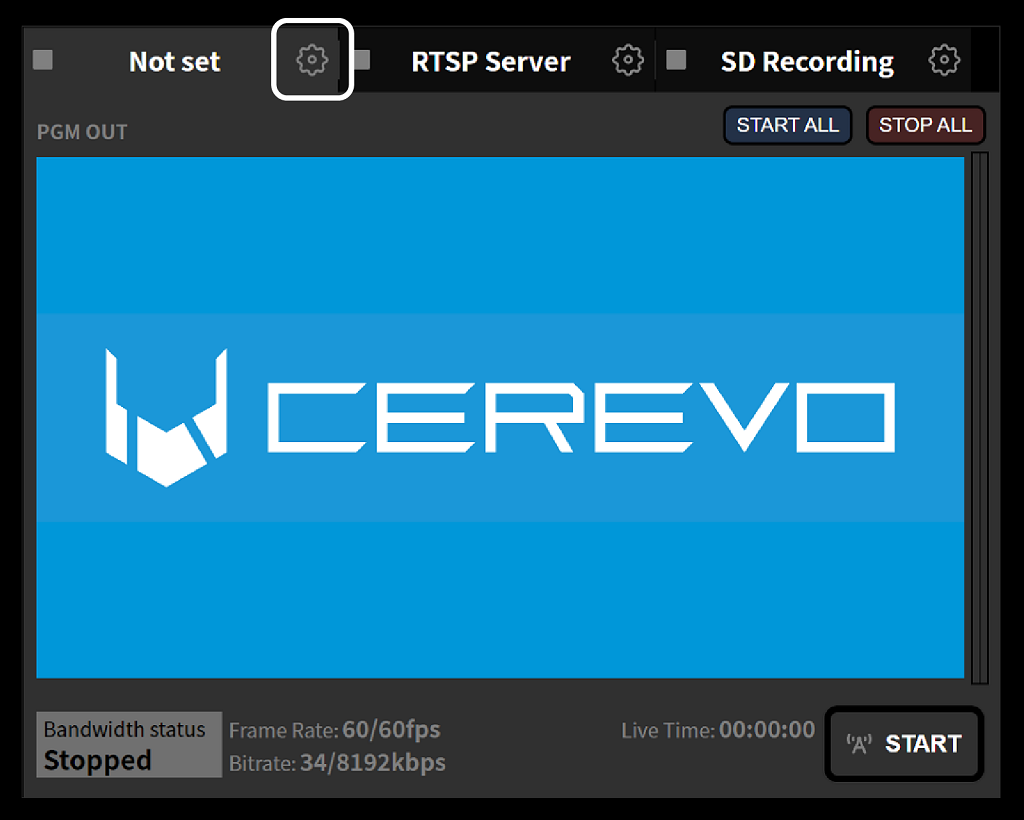
The factory default settings, as for an example of the settings, "RTSP Server" is pre-set on Channel 2 and "SD Recording" is pre-set on Channel 3. No pre-setting on Channel 1. The following procedure based on the assumption that a new setting is put into Channel 1, but it is acceptable to rewrite Channel 2 and Channel 3.
On the settings screen that appears, click "Edit" button for the channel you wish to change. In this example, Channel 1 is selected.

Click "+Add new streaming target".

Enter the values on the screen that appears, then click "Save".
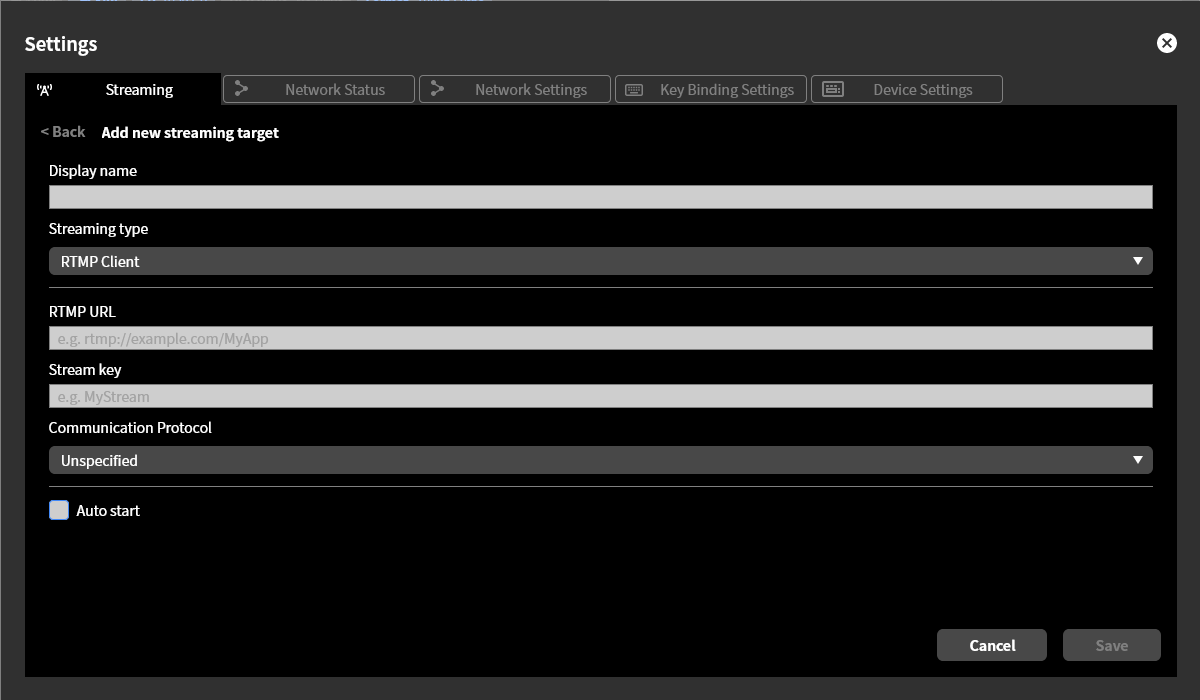
The values to be entered depend on the live streaming target type setting. Please refer to the instructions below.
For RTMP Clients RTMP client settings
For RTSP servers RTSP server settings
For recording Recording settings
For MPEG2-TS over UDP MPEG2-TS over UDP settingsClick "Select" button for the created live streaming target, and it will be selected as the streaming target for Channel selected in step 2.

Settings by target type
RTMP client settings
For the streaming type "RTMP Client", the following settings are required.

"Display Name" can be any name (e.g., ExampleTube)
"RTMP URL" enter the RTMP URL obtained from the live streaming platform. The followings are examples.
To use the default port 1935/tcp with plain text RTMP
rtmp://rtmp.example.jp/liveTo use explicitly specify port 11935/tcp with plaintext RTMP
rtmp://rtmp.example.jp:11935/live.To use the default port 443/tcp with TLS-encrypted RTMP
rtmps://rtmp.example.jp/live
Enter the stream key obtained from the live streaming platform in "Stream Key" field.
“Communication protocol", specify the network layer protocol. It can be Unspecified, IPv4 or IPv6
If "Unspecified" is selected, first it processes the RTMP URL host name resolution. If AAAA records are obtained, attempt to connect to them in IPv6, giving priority to AAAA records. If connection to all IPv6 hosts fails, it will attempt to connect to the host with IPv4 if it has an A record.
If “IPv4” is selected, first resolve the hostname in the RTMP URL. Then using only A record, attempts to connect to the host with IPv4.
If "IPv6" is selected, first resolve the hostname in the RTMP URL. Then using only AAAA record, attempts to connect to the host with IPv4.
If "Auto-Start" is checked ☑, the live streaming to this target will be started automatically when this product is booted.
RTSP server settings
The following settings are required for RTSP streaming type.
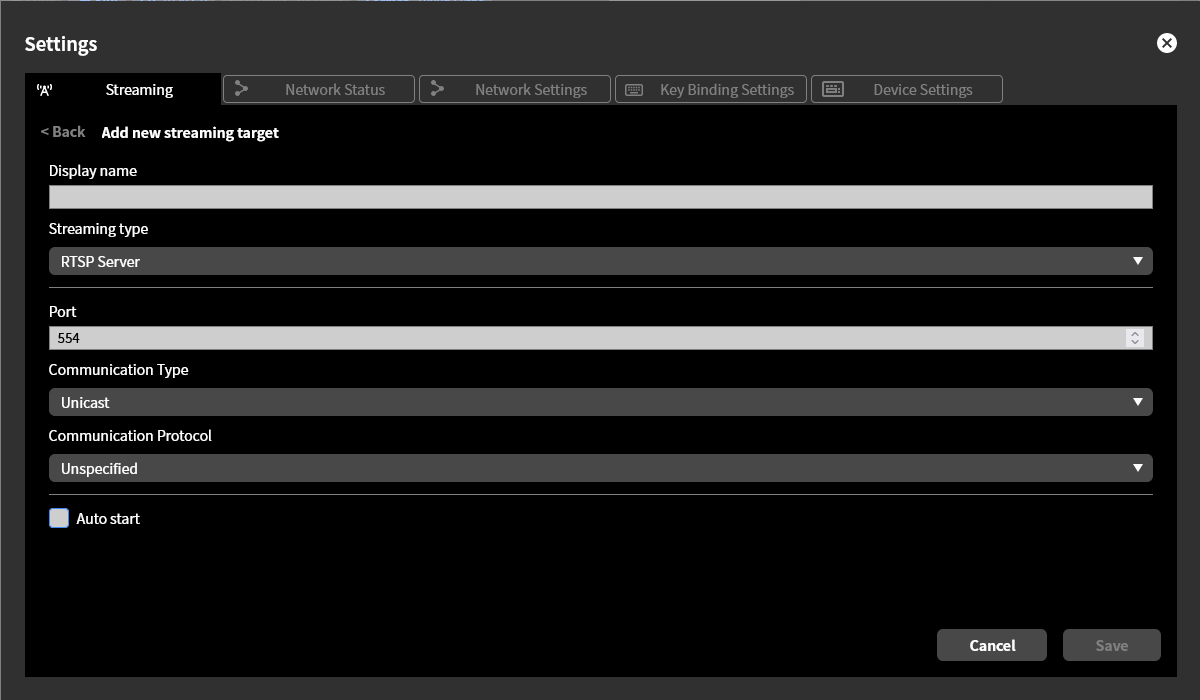
"Display Name" can be any name (e.g., RTSP Server)
Enter the TCP port that the RTSP server listens on in the "Port" field. Normally, use 554.
“Communication Method" is whether to send media packets by unicast or multicast. Normally, select "Unicast".
“Communication Protocol" specify the network layer protocol. It can be Unspecified, IPv4 or IPv6.
If "Unspecified" is selected, the device listens for both IPv4 and IPv6 addresses.
If "IPv4" is selected, the server listens for IPv4 addresses only.
If "IPv6" is selected, the server listens for IPv6 addresses only.
If "Auto Start" is checked ☑, the RTSP server will start automatically when this product is booted.
RTSP server cannot be set for multiple channels; only one channel can be set as RTSP server.
Recording settings
For "Recording", the following items settings are required.

"Display name" can any name (e.g., Recording)
"Container" specify the container format to use when saving the stream, "MP4" or "MPEG2-TS".
"Recording Media" specify the recording media you record to, "SD card" or "USB drive".
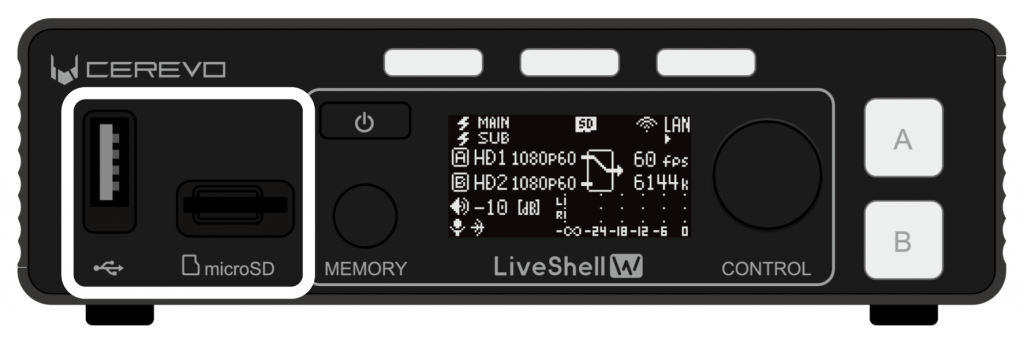
Based on the selection, connect the recording media to microSD card slot or USB port on the front of the unit.
If "Auto Start" ☑ is selected, recording will start automatically when this product is booted.
The recording function does not support more than one channel. Only a single channel can be used for recording.
MPEG2-TS over UDP settings
For the streaming type "MPEG2-TS over UDP", the following items settings are required.
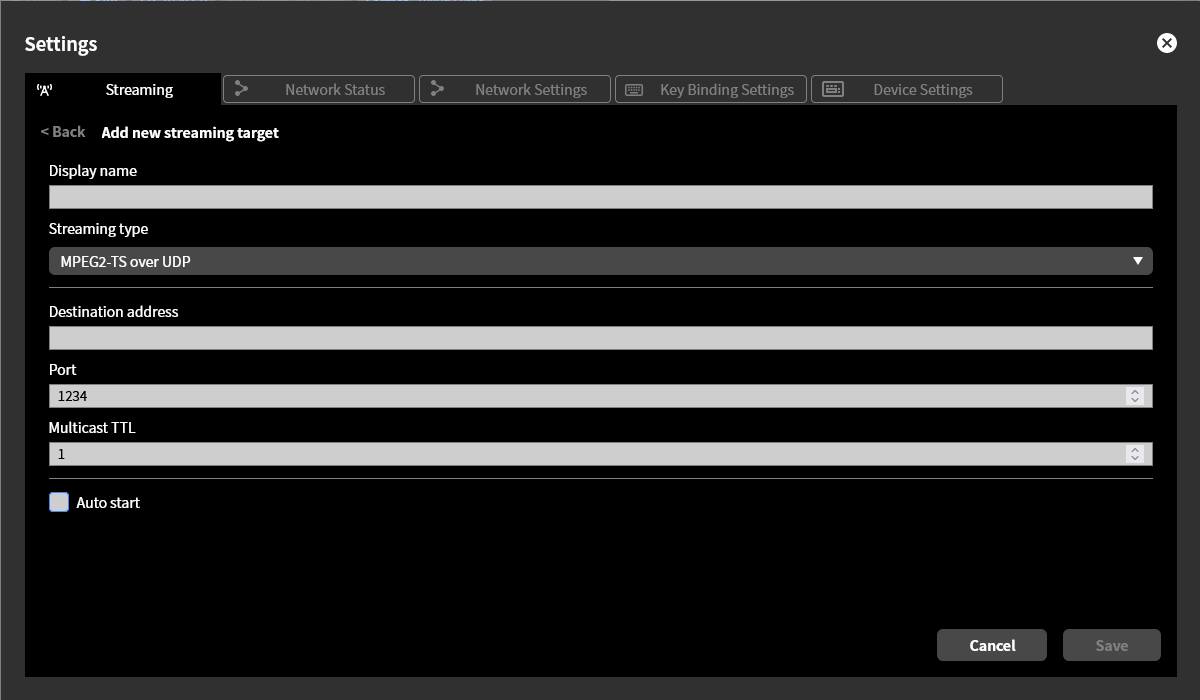
"Display name" can any name (e.g., UDP)
"Destination address" field, enter the target (destination) IP address the UDP datagrams will be sent to.
"Port" field, enter the target (destination) port number of the UDP datagram to be sent in.
“Multicast TTL” field, enter the Time To Live value if you do multicast delivery.
If "Auto Start" (☑) is selected, the live streaming to this target will start automatically when this product is booted.
Changing or deleting live streaming channels
To change or delete a live streaming target channels, do the following;
Click the gear symbol at the top of the program output screen.
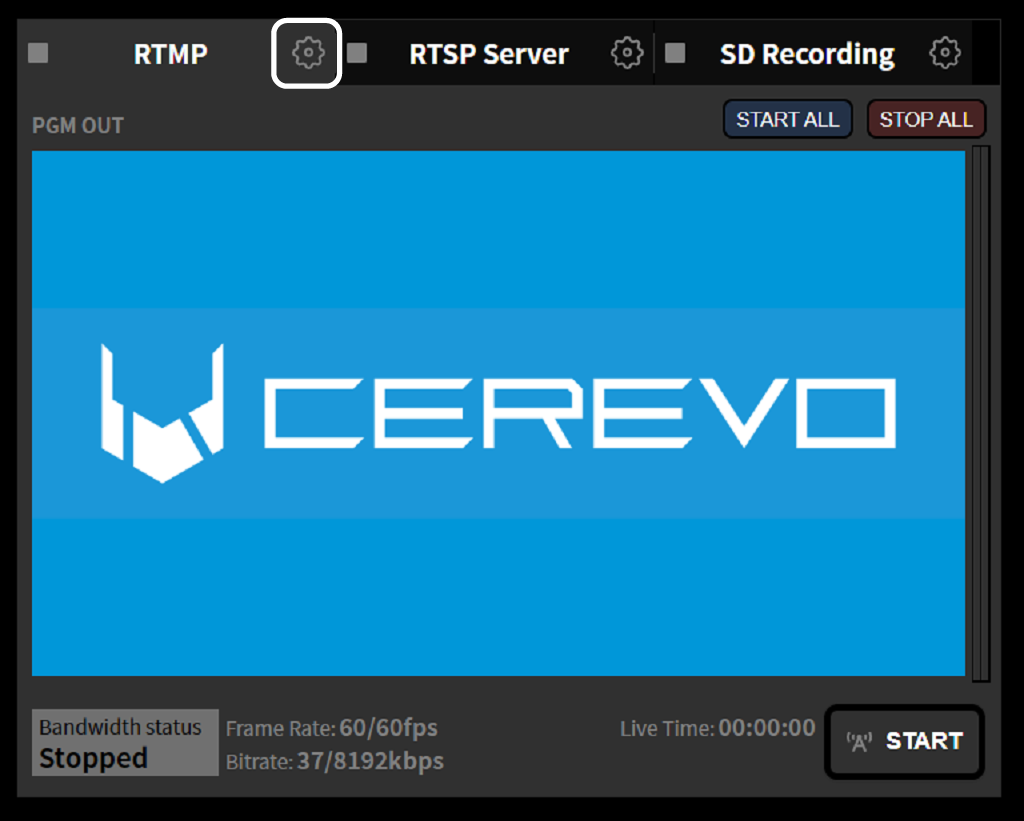
If you want to change the live streaming target, click the "Edit" button on the setting screen that appears. In this example, Channel 1 is selected.

A list of streaming targets (destinations) will be displayed. Select the target you wish to set as the new channel (-> Basic operation of target settings).
To delete a streaming targets that has already been set, click the "Remove" button on the settings screen. In this example, Channel 1 is selected.

If you delete a live streaming channel setting, the setting for that channel will be set to "Not set". However, the target settings are not deleted. To edit or delete a streaming target setting, follow the instructions in Editing and deleting target Settings.
The streaming target channel can not be changed or deleted during live streaming. This operation must be performed after the live streaming has been stopped.
Editing and deleting target Settings
To edit or delete a target setting, do the following;
Click on the gear symbol at the top of the program output screen.

Click "Manage streaming targets" button
Click "Edit" or "Delete" button for the target you wish to edit or delete.
When editing, edit the streaming target type accordingly(→ Settings by target type).
Live streaming destinations used as Channel settings cannot be deleted. This operation must be performed after the target has been deleted from the channel (→ Changing or deleting live streaming channels).
Starting and stopping live streaming or recording
To start and stop streaming or recording for a given channel, do the following. This operation is available with either the LiveShell Studio or the buttons on the main unit.
Start live streaming or recording
Click Channel tab at the top of the program output screen you wish to start or record.
Click "Start" button displayed in the lower right corner to start live streaming or recording the live streaming.
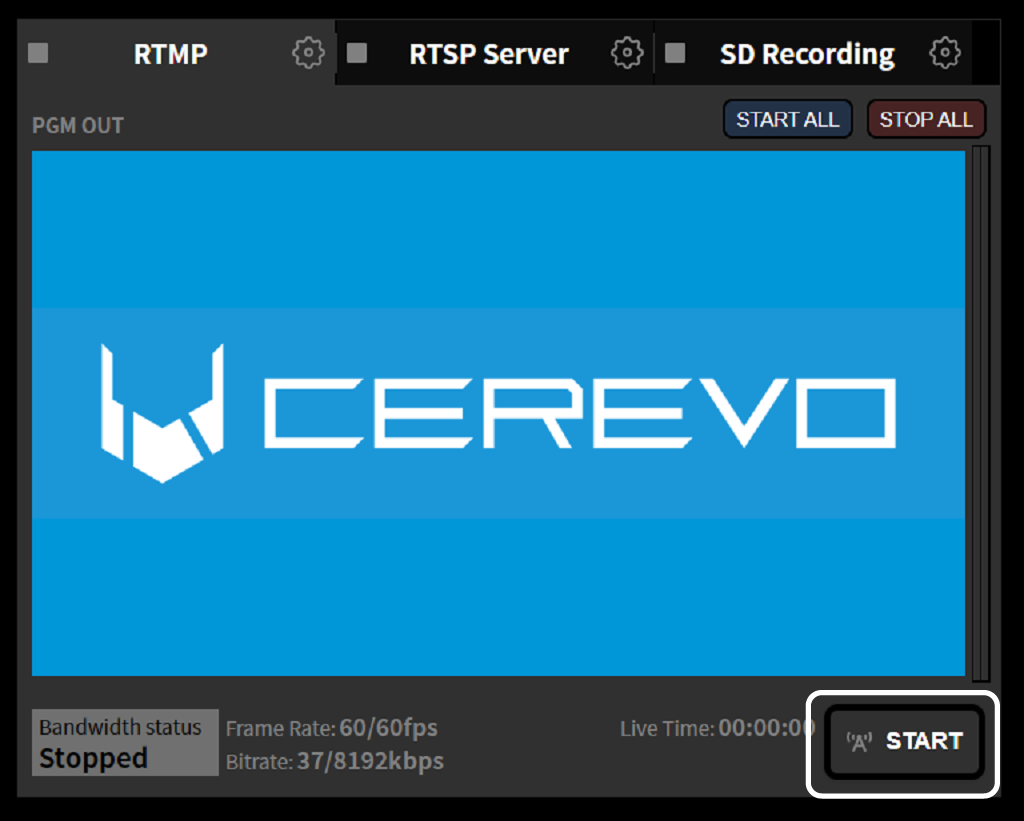
To operate all channels at once, click "START ALL" button.

Stop live streaming or recording live streaming
Click Channel tab at the top of the program output screen you wish to stop.
Click "Stop" button displayed in the lower right corner to stop live streaming or recording.
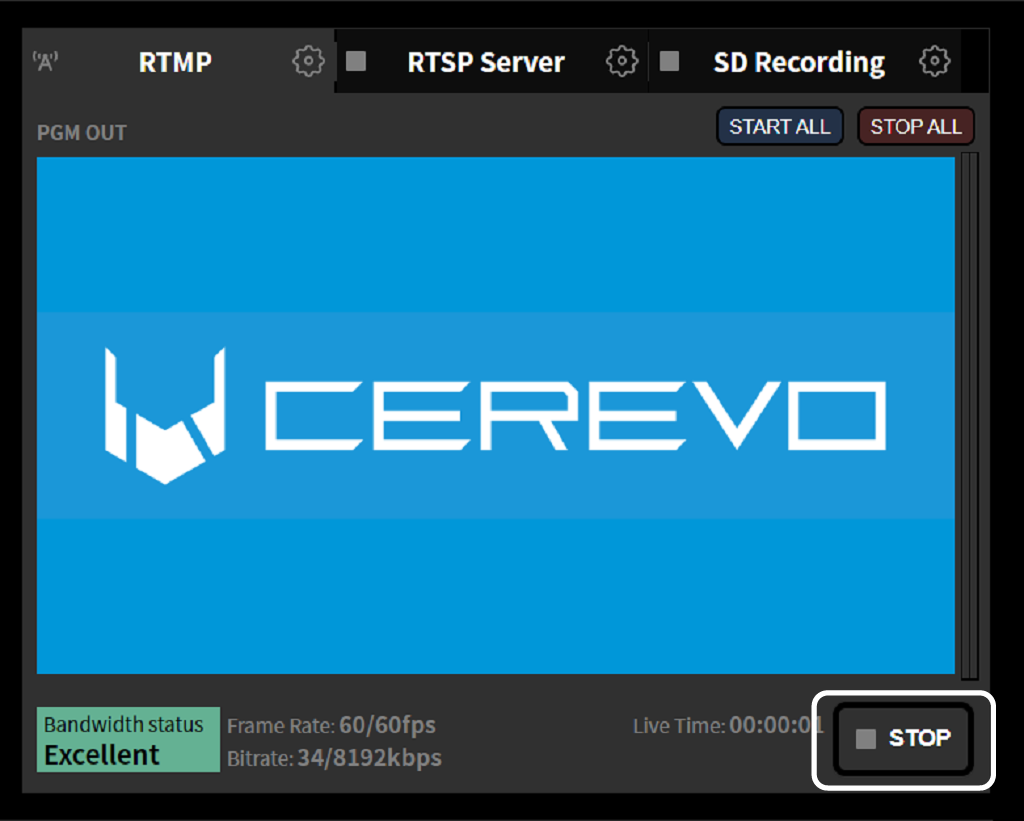
To operate all channels at once, click "STOP ALL" button.
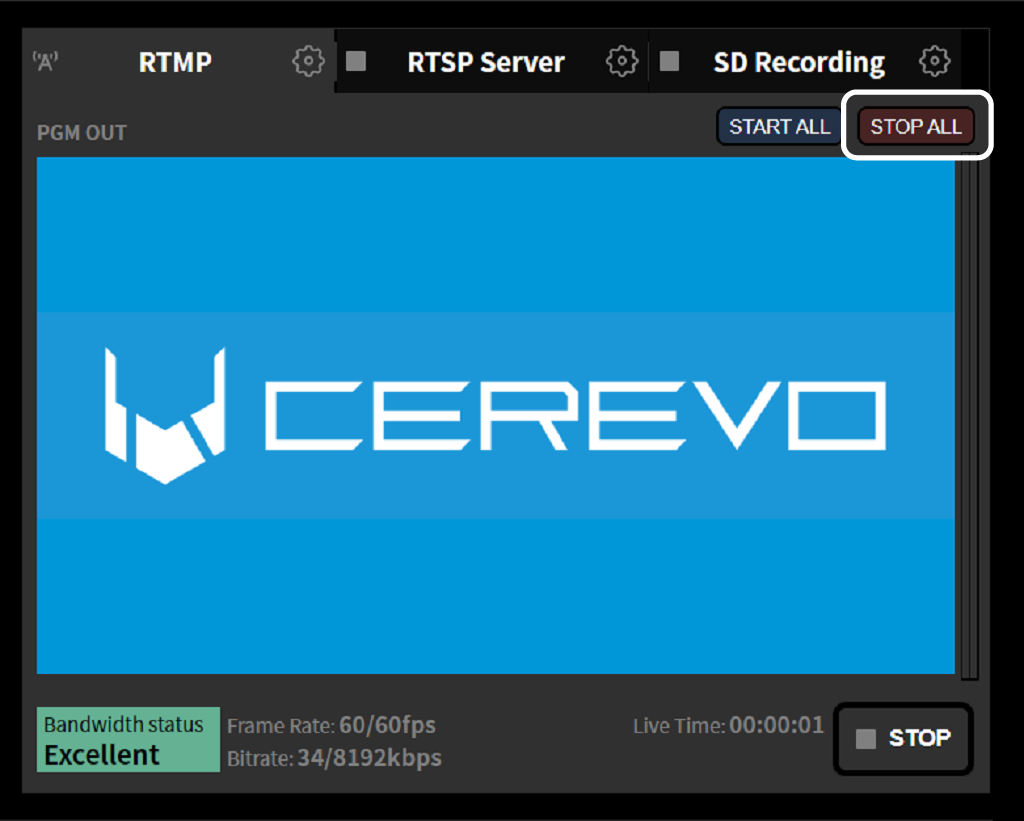
System Management
Factory reset
Unit Main Menu / MAIN MENU → System → Factory Reset
LiveShell Studio / Settings → Device Settings tab → Factory Reset
This is a function to delete all the settings of this product and restoring it to the factory defaults, which can be done by either LiveShell Studio or the main unit.
Factory reset by main unit operation
Use the control dial to navigate to MAIN MENU → System → and select Factory Reset. In addition, push and hold the video select button A for 2 seconds to perform a factory reset and reboot.

Factory reset by LiveShell Studio
Click "Factory Reset" in the Settings on Device Settings tab. Select "Yes" to confirm and perform a reset and reboot.

Forced shutdown
If this product cannot be turned off by normal shutdown operation (→ How to shut down this product) and you need to perform a forced shutdown, unplug the power supply cable or push and hold the power button on this product for 10 seconds or more.
Firmware update
How to check for updated firmware
To check the firmware version or update for this product, do the following in LiveShell Studio.
Click "Settings" in the upper left corner of the LiveShell Studio application screen.
Click "Main unit settings" tab on the settings screen that appears.
Click "Check Update" button on the right side of "Firmware version".
Check the message displayed on the right side of the button.
"The latest version is installed.”; there is no need to update the firmware.
“A new update is available. Click here to download.”; Click on that part of the message and proceed to the next step.
Follow the instructions on the download page to update.
How to update the firmware
For instructions on how to update the firmware, see the separate document Firmware Update Guide.
FAQ
Frequent asked questions
No information.
Troubleshooting
No information.
Confirmed live streaming platforms
The following is a list of live streaming platforms which we have verified LiveShell W (This is the result of our own verification and does not guarantee operation. Please refrain from inquiring about the results of the verification to the respective platform providers.)
Platform name |
Recommended encoding setting information |
|---|---|
YouTube Live |
|
ニコニコ生放送 |
|
ツイキャス |
|
Facebook Live |
|
Twitch |
|
Wowza |
|
vimeo |
Specifications
Specification |
Unit |
Note |
|||
|---|---|---|---|---|---|
Encoding |
Video |
Video encoding |
H.264 |
||
Max resolution |
1920 × 1080 |
Dot |
|||
Max frame rate |
60 |
FPS |
|||
MAX bitrate range |
128 ~ 20,480 |
kbit/s |
|||
Audio |
Audio encoding |
AAC-LC |
|||
# of Channel |
2 |
Channnel |
|||
Sampling rate |
48 |
kHz |
|||
Bit depth |
16 |
bit |
|||
Output bitrate |
48 ~ 256 |
kbit/s |
|||
Streaming |
Protocol |
RTMP/RTMPS Client |
|||
Simultaneous |
3 |
Stream Starget |
* Each streaming target is the same encoder stream. |
||
Recording |
Supported media |
microSD Card or USB Drive (exFAT・FAT32 format) |
|||
Recording stream |
The same encoder stream as streaming output |
||||
Video |
Switching |
# of Input |
2 |
||
Switching effect |
Cut、Mix、Wipe |
||||
Video |
Composite Effects |
Picture-in-Picture, Chroma Key |
|||
Caption composite |
Text arrangement, transparent PNG image composition |
*Only full screen images are supported. |
|||
Input |
Video |
# of input |
2 |
Input |
|
Transmission method |
HDMI |
*HDCP is not supported |
|||
Supported input format |
1080p/60(59.94), 1080p/50, 1080p/30(29.97), |
*When using two HDMIs, the both of them must have the same format. |
|||
I/P conversion method |
Field coupling method |
*If an interlaced format is input, it is automatically converted to progressive. |
|||
Digital audio |
# of input |
2 |
|||
Transmission method |
HDMI Audio (shared with video input) |
||||
Analog audio |
# of input |
2 |
|||
Audio input |
LINE, MIC |
* Each input can be mixed with HDMI Audio |
|||
Output |
Video |
# of Output |
1 |
*For program confirmation video output |
|
Transmission method |
HDMI |
||||
Output format |
1080p/60(59.94), 1080p/50, 1080p/30(29.97), |
*The output format is the same as the input format. |
|||
Digital audio |
# of Output |
1 |
|||
Transmission method |
HDMI Audio (shared with video input) |
||||
USB |
# of port |
2 |
Port |
* 1 port on the front, 1 port in the rear. |
|
Connectable devices |
Wireless LAN adapter or LTE connection modem |
||||
Connectable devices |
Dedicated controller, HID keyboard, USB mass storage, USB audio class device |
*Dedicated controller is under development. |
|||
Network |
Ethernet |
Connecting interface |
10BASE-T/100BASE-TX/1000BASE-T |
||
# of port |
1 |
Port |
|||
Wireless |
Connecting interface |
Wireless LAN (802.11a/b/g/n/ac) |
*A separate wireless LAN adapter is required. |
||
Wireless LAN |
Infrastructure mode or AP mode |
||||
Network protocol |
IPv4 / IPv6 |
||||
Address setting |
DHCP or Fixed (IPv4), SLLAC (IPv6) |
||||
User |
Unit |
Display function |
128 x 64 dot OLED display |
||
Power supply operation |
Power button |
||||
Menu operation |
Control dial, button |
||||
Video/streaming |
Streaming button indicator, Video Select button A/B |
||||
External |
Built-in HTTP server |
Can be operated from a browser on a PC, tablet, etc. |
|||
Built-in application |
LiveShell Studio |
||||
Power supply |
Input |
# of input |
2 |
* Redundancy is possible |
|
Port |
USB Type C |
||||
Voltage |
5 |
V |
|||
Max current |
3 |
A |
|||
Supported |
AC adapter or portable power bank, etc. |
||||
Others |
Size |
W 145 × D 100 × H 42 |
mm |
*Excluding the protruding parts. |
|
Weight |
Approx. 500 |
g |
*Without any accessories. |
||
Included |
CDP-LS05A |
Wi-fi adapter, |
